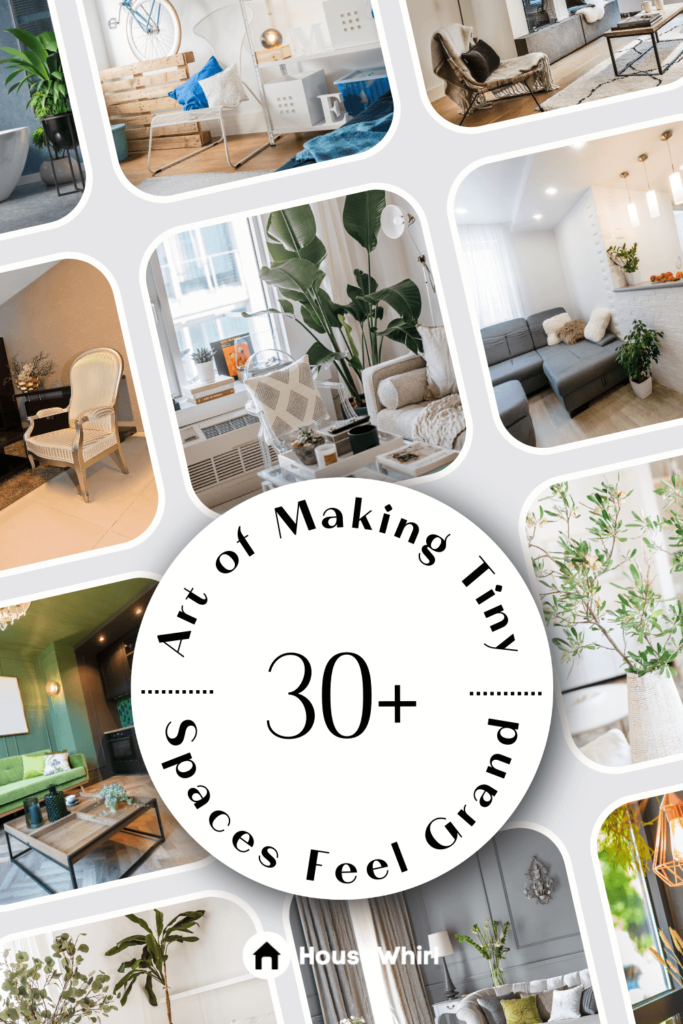
Transforming a compact space into an oasis of luxury might seem like a daunting task, but it’s entirely possible with the right strategies.
Many homeowners grapple with the challenge of making their small homes feel more spacious and opulent without breaking the bank. This common predicament often leads to frustration and dissatisfaction with one’s living environment.
However, there’s no need to despair! With clever design tricks and thoughtful consideration of your space, achieving a grandeur aesthetic in even the most modest home is within reach.
In this article, you’ll learn how strategic decor choices, innovative storage solutions, and smart color palettes can not only maximize your space but also infuse it with a sense of luxury that belies its actual size.
1. Declutter

The act of decluttering transcends mere tidying; it’s a transformative process that bestows upon your small home the luxury of space and serenity. In environments where square footage is at a premium, every inch counts, making decluttering not just beneficial but essential for creating an expansive feel.
Adopting a minimalist approach can dramatically enhance the perception of size in any room. By selectively curating possessions and retaining only those items that serve a purpose or spark joy, you open up physical space while also cultivating an atmosphere of calm elegance. This isn’t about stripping away character but refining it—ensuring that each piece contributes positively to your home’s ambiance.
Consider implementing smart storage solutions as part of your decluttering strategy. Hidden compartments, multi-functional furniture, and vertical storage options can all help maintain order without encroaching on valuable living space. The goal here is to create a place for everything and keep everything in its place, thereby avoiding visual clutter that can make rooms feel cramped and chaotic.
Furthermore, regularly reassessing what you own encourages ongoing engagement with your space, allowing it to evolve alongside your needs without becoming cluttered again. It fosters an environment where luxury is defined not by excess but by the thoughtful selection and arrangement of belongings—a sanctuary characterized by openness and tranquility.
2. Mirrors
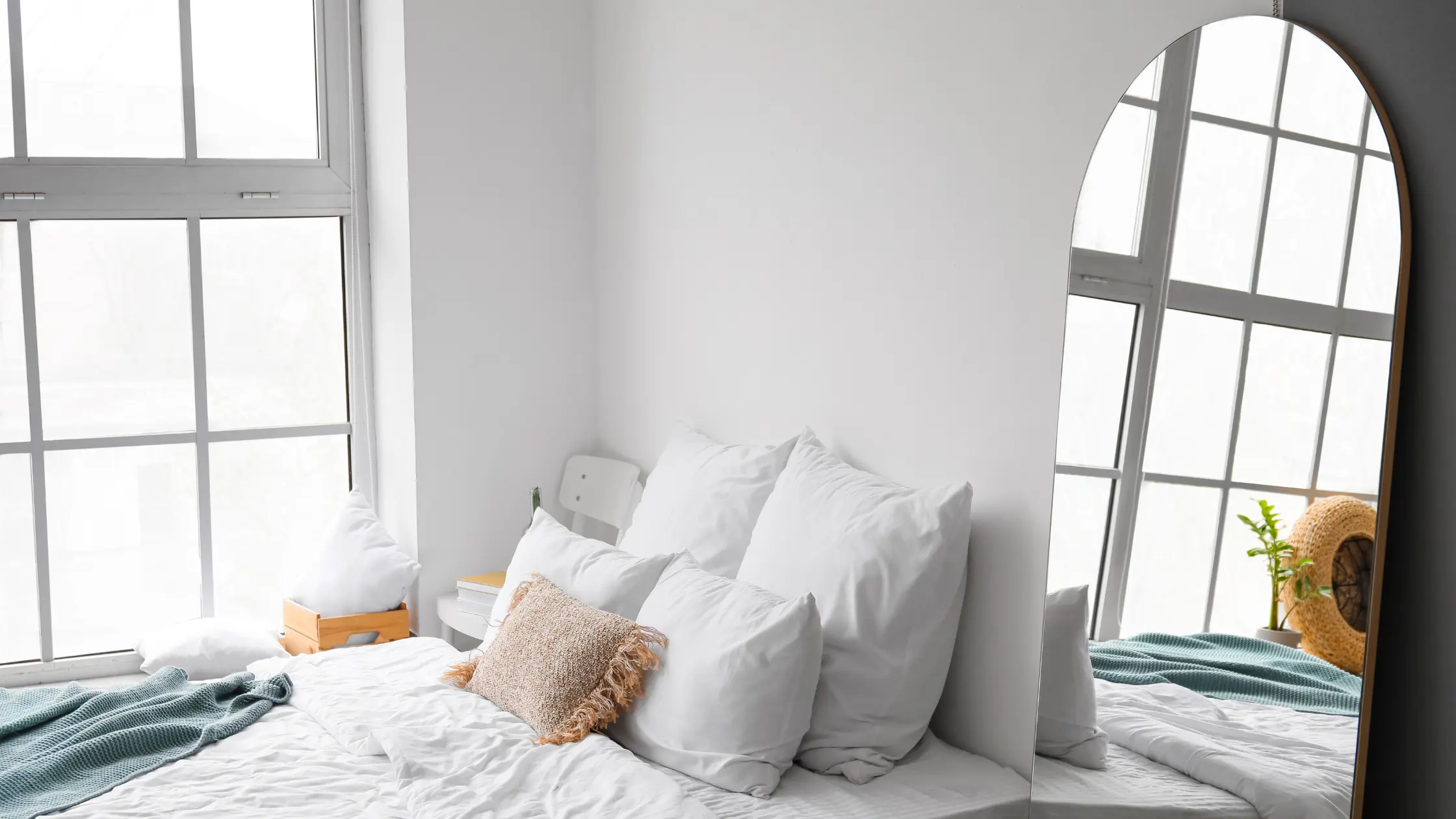
When it comes to mirrors, their power in transforming a small living space into one that feels expensively luxurious cannot be overstated. More than just tools for personal grooming, mirrors serve as magical elements in interior design, particularly in compact homes. These reflective surfaces excel at creating an illusion of depth and enhancing natural light, two critical components when aiming for a spacious ambiance.
Strategically placing mirrors across from windows can instantly double the amount of sunlight streaming into your room. This not only brightens up your space but also makes it feel airier and more open. It’s like inviting the outdoors inside, without needing extra square footage.
But why stop there? Mirrors can also be used as statement pieces or focal points within a room. A large floor-to-ceiling mirror leaning against a wall acts as a window-like feature that tricks the eye into perceiving more space behind it. Similarly, incorporating mirrored furniture or decorative items adds layers of sophistication while contributing to the spatial expansion effect.
For those looking to amplify this impact further, consider using multiple smaller mirrors arranged artistically on a single wall. This approach not only enlarges the room visually but also adds character and elegance, reflecting various angles of your beautiful home back at you.
3. Keep Your Floor Visible
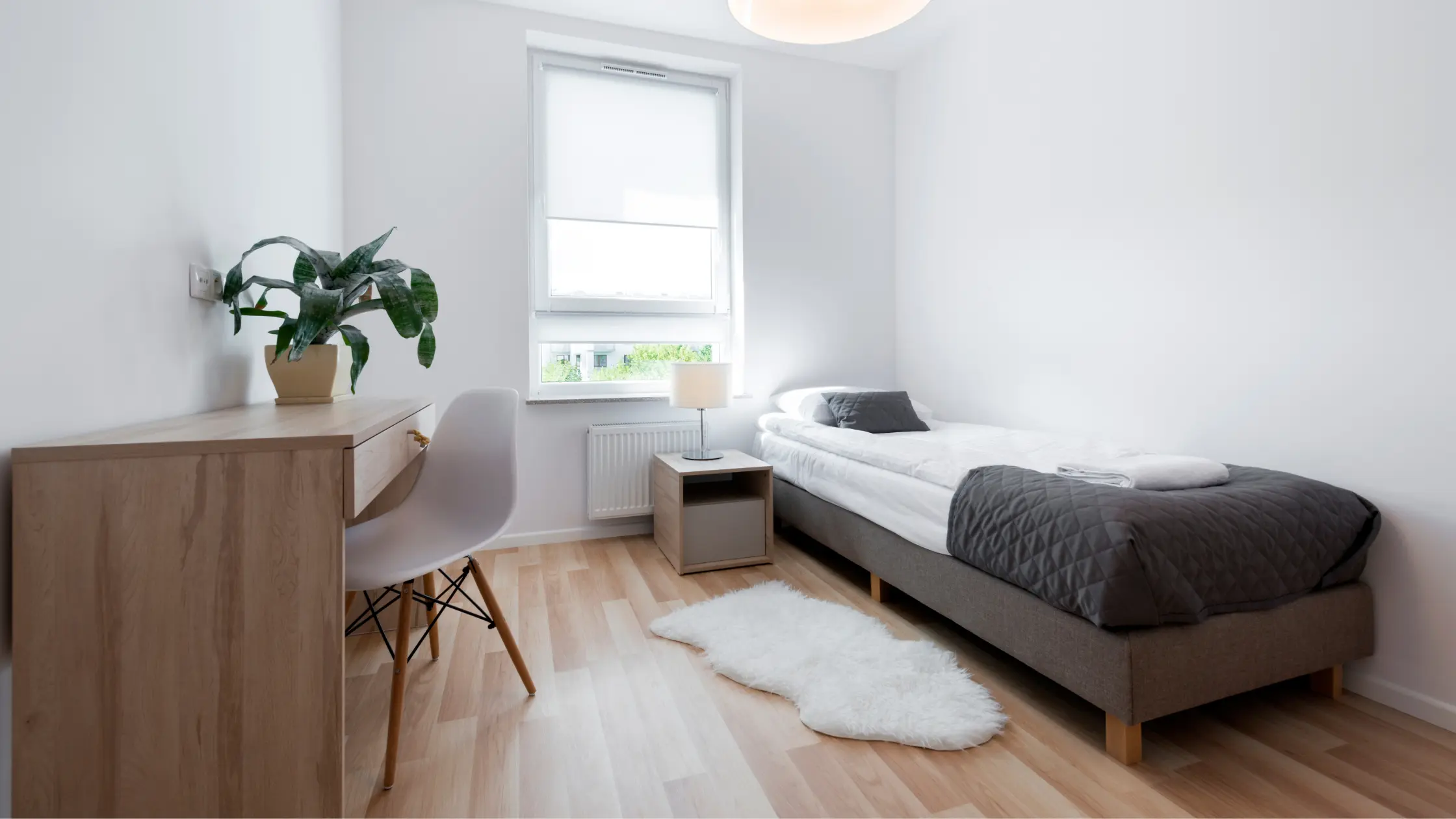
Keeping your floor visible is a deceptively simple yet profoundly effective tactic in crafting the illusion of spaciousness within small homes. This design principle emphasizes minimal obstruction of floor space, encouraging an open and airy feel that significantly contributes to the overall perception of luxury.
Opting for furniture with raised legs plays a pivotal role in achieving this objective. Sofas, chairs, and tables that allow light to pass underneath them reduce visual weight and create a sense of fluidity throughout the room. This subtle elevation not only enhances cleanliness but also adds an elegant dynamism to the living area.
Strategic placement is equally important; ensuring pathways remain unblocked promotes ease of movement, further expanding the room’s perceived boundaries. It’s about striking a balance between functionality and openness—arranging items in a way that facilitates flow rather than clutter.
Incorporating floating shelves or wall-mounted storage solutions can also keep floors clear while displaying decorative items or books. Such alternatives leverage vertical space effectively without sacrificing style or personal expression.
Additionally, choosing lighter-colored flooring or rugs can brighten interiors dramatically—making rooms appear larger by reflecting more light. When paired with careful furniture selection and arrangement, these surfaces serve as the foundation for an expansive-looking home environment.
4. Sliding Doors

Sliding doors stand as a modern, space-saving solution that significantly contributes to making small homes feel luxuriously big. By replacing traditional hinged doors with sliding counterparts, homeowners can reclaim valuable floor and wall space, allowing for more fluid and flexible room layouts.
The beauty of sliding doors lies in their versatility; glass panels invite natural light to flow freely between rooms, enhancing openness and connectivity while maintaining the option for privacy. For spaces where light control is essential, frosted or tinted glass options provide an elegant compromise.
In addition to their practical benefits, sliding doors add a sleek architectural element to interiors. Materials like wood or metal can be chosen to complement the home’s design theme—whether aiming for warm rustic charm or minimalistic urban chic.
Furthermore, mirrored sliding doors serve a dual purpose; they not only create the illusion of depth by reflecting interior spaces but also double as full-length mirrors—a boon in bedrooms or dressing areas where spatial economy is critical.
For those looking to delineate zones without physical barriers, consider using ceiling-mounted tracks for movable panels. This approach allows homeowners to adapt their living areas based on current needs—open up spaces for entertaining or close them off for cozy solitude—all while preserving an uncluttered aesthetic.
5. Monochromatic Scheme
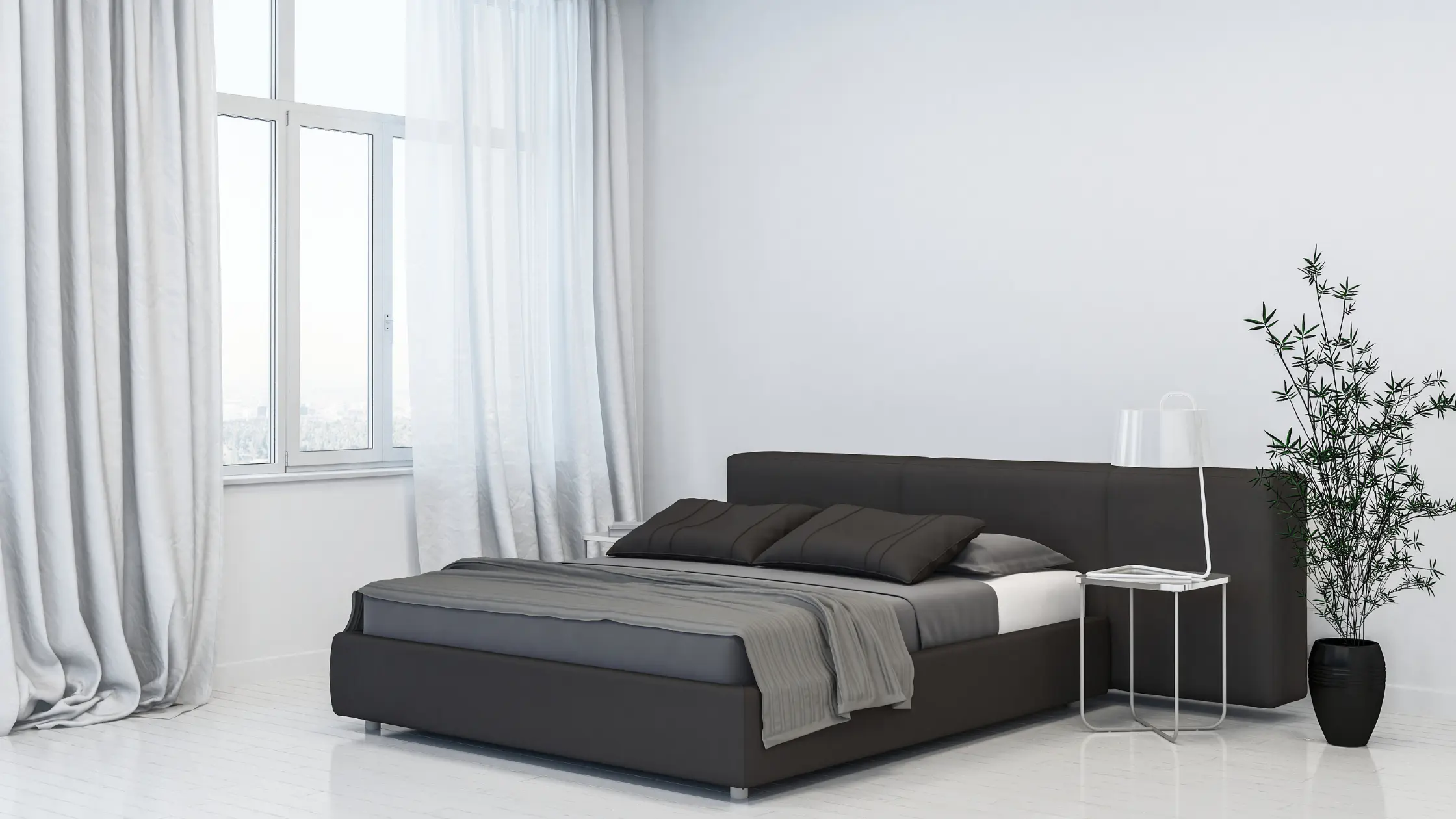
Adopting a monochromatic scheme is a refined approach to designing small homes in a way that enhances their sense of spaciousness while exuding an air of luxurious simplicity. This design strategy involves selecting varying shades, tints, and tones within a single color palette to create depth and interest without the visual chaos that can accompany more complex color schemes.
The strength of monochromatic interiors lies in their cohesive appearance; by limiting contrast, rooms flow seamlessly into one another, creating an expansive feel beyond the confines of physical walls. This unity tricks the eye into perceiving spaces as larger than they are—a crucial consideration for enhancing compact living environments.
To prevent monotony and add layers of richness to your decor, mix textures and materials within your chosen hue. For instance, combining soft fabrics with reflective metals or matte finishes with glossy accents introduces tactile diversity that keeps the space dynamic yet harmonious.
Natural light plays a pivotal role in illuminating monochromatic spaces—enhancing their openness and elevating the overall ambiance. Strategic lighting design, including both natural sources and well-placed fixtures, ensures shadows and highlights work together to accentuate architectural features without fragmenting the aesthetic unity.
Furthermore, incorporating subtle patterns or minimalist graphic elements can inject personality into your home while maintaining its serene monochrome palette.
6. Quality Over Quantity
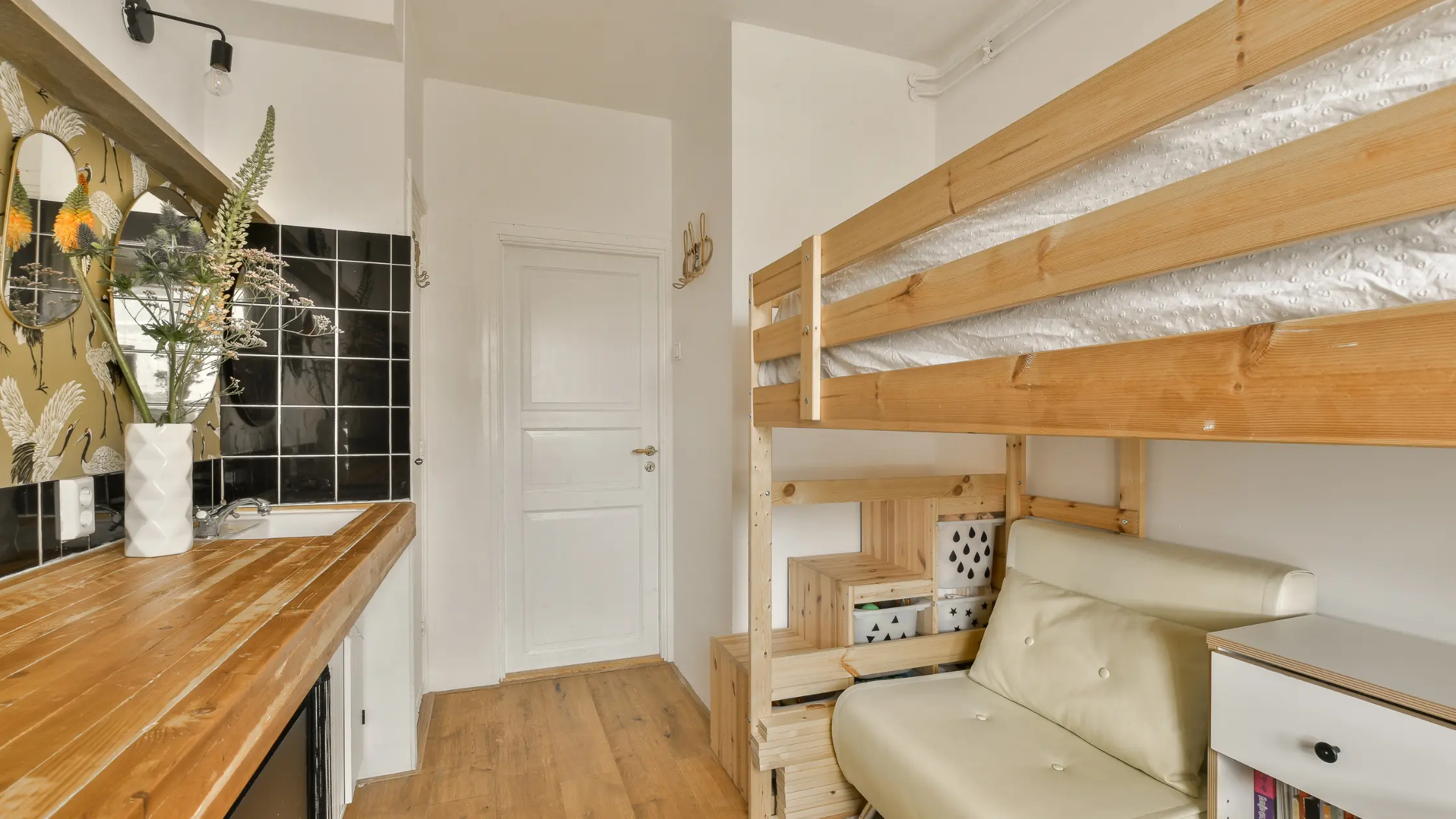
Emphasizing quality over quantity is a pivotal design principle for transforming small homes into spaces that feel both luxuriously expansive and intimately curated. This approach advocates for carefully selecting fewer, but more meaningful and well-crafted items instead of filling rooms with an abundance of furnishings and decor. By focusing on the intrinsic value and aesthetic appeal of each piece, homeowners can create a refined environment where every object holds significance.
Choosing high-quality materials and furniture not only ensures durability but also adds a touch of sophistication to the home. For example, investing in a beautifully designed sofa or an heirloom-quality dining table can serve as a focal point in your living space, around which other elements harmoniously converge.
Such selectivity extends beyond mere functionality; it’s about creating an emotional resonance within your home—a sanctuary that reflects personal style and values through craftsmanship rather than sheer volume. This selective process encourages mindful consumption, leading to uncluttered spaces that breathe elegance and simplicity.
Texture plays a crucial role in this minimalist yet luxurious setting; rich fabrics, natural wood grains, or artisanal ceramics provide sensory depth without cluttering visual landscapes.
Moreover, integrating versatile pieces that adapt to various needs—like modular storage systems or convertible furnishings—further exemplifies how prioritizing quality over quantity can maximize utility while maintaining sleek aesthetics.
7. Large Windows
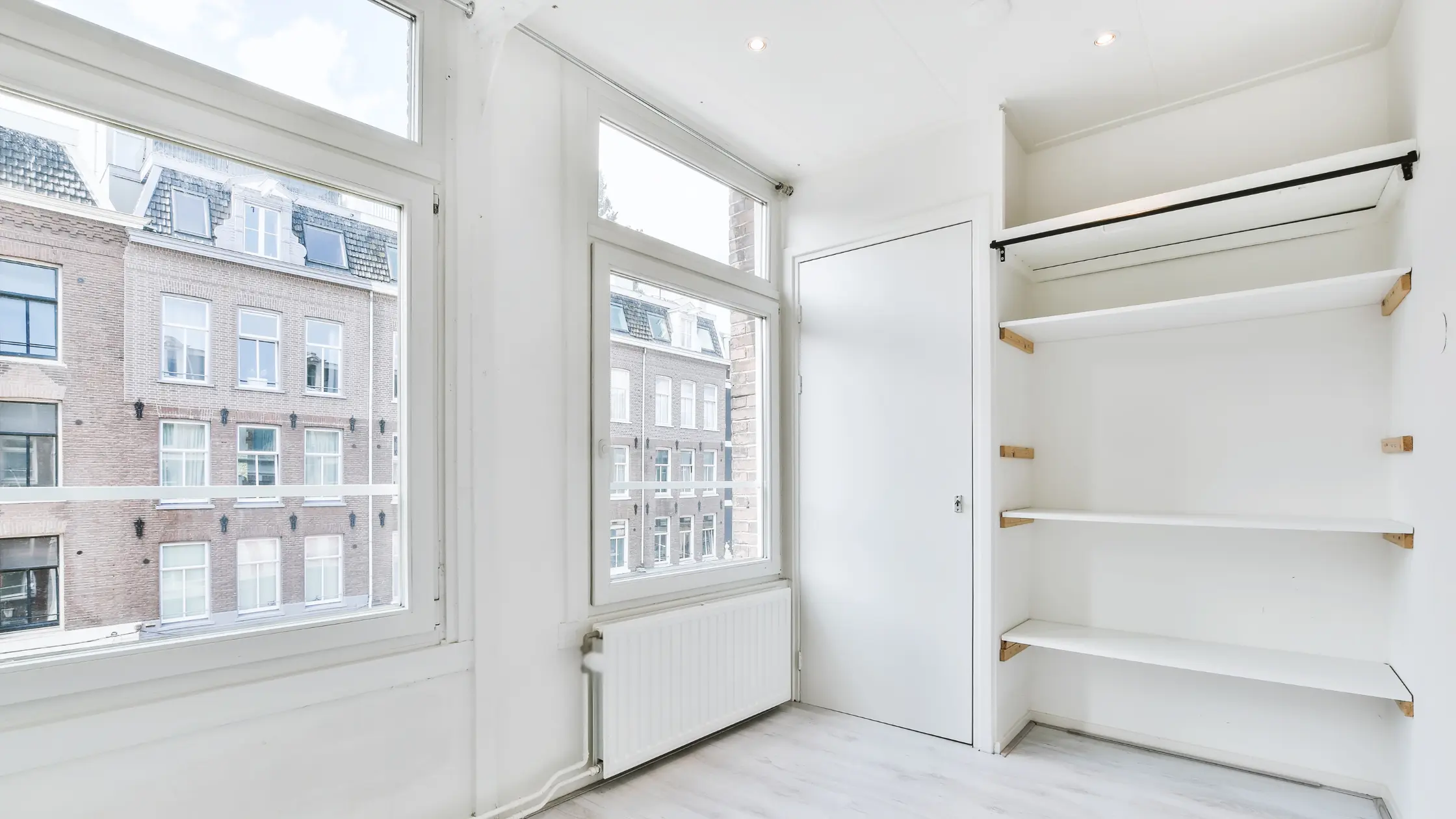
Featuring large windows in your home design is a transformative approach to making small spaces feel luxuriously big. By inviting ample natural light and offering expansive views of the outdoors, these architectural elements instantly create an airy, open atmosphere that visually extends beyond the interior confines.
The strategic placement of large windows can significantly impact how spacious a room feels. Positioning them to capture the beauty of a sunrise or sunset not only maximizes light exposure but also enhances your connection with nature—blurring indoor-outdoor boundaries for an added sense of freedom and expansiveness.
When considering window treatments, opting for sheer curtains or minimal shades ensures daylight isn’t obstructed while still providing privacy when needed. This careful balance allows homeowners to harness the full potential of their sizable windows without compromising on comfort or aesthetic appeal.
Furthermore, aligning furniture layouts to face or surround these windows can magnify their effect; creating cozy nooks near views offers the perfect spot for relaxation and contemplation, reinforcing the luxurious aspect of spacious living.
To accentuate height and add another layer of sophistication, consider floor-to-ceiling designs that draw the eye upwards—further elevating ceilings appear and enhancing spatial perception.
8. Transparent Window Treatments

Opting for transparent window treatments is a subtle, yet effective strategy to enhance the spaciousness and luxury of small homes. This approach focuses on maximizing natural light penetration and preserving exterior views, which are crucial elements in creating an illusion of extended space beyond the physical walls.
Sheer curtains or lightweight blinds can serve this purpose beautifully. They allow sunlight to filter through softly, illuminating interiors with a warm glow while providing just enough privacy. The translucency of these materials also maintains a visual connection with the outdoors, making rooms feel larger and more open.
One key benefit of transparent window treatments is their ability to blend seamlessly into any decor style without overwhelming it. Their understated elegance adds a layer of sophistication that complements rather than competes with other design elements in your living space.
For those seeking versatility, consider installing roller shades made from semi-transparent fabrics. These can be easily adjusted throughout the day to control light levels and visibility according to your needs—ensuring comfort without sacrificing the airy ambiance essential for luxurious living.
Furthermore, pairing these light-permitting treatments with strategically placed mirrors amplifies their effect—reflecting daylight deep into rooms and further enhancing the perception of depth.
9. Smart Home Technology

Integrating smart home technology into small living spaces is a forward-thinking approach to enhancing both functionality and the perception of luxury. By adopting intelligent systems, homeowners can streamline their environments, creating seamless, efficient, and customizable living experiences that contribute to an aura of spaciousness.
Voice-activated assistants can control lighting, temperature, and entertainment systems with simple commands—a feature that not only elevates convenience but also reduces the need for physical switches and controls cluttering walls or taking up surface space. This minimalistic approach contributes significantly to maintaining clean lines and an unobstructed flow throughout the home.
Smart lighting solutions offer another layer of sophistication; programmable LEDs can adjust in color temperature and brightness to mimic natural light cycles or create ambiance tailored for specific activities or times of day. The ability to manipulate lighting so precisely further expands the sense of space by drawing attention away from size constraints towards design elements.
Moreover, smart storage solutions such as automated shelving units maximize vertical space efficiency while keeping belongings neatly tucked away until needed—reinforcing orderly aesthetics essential in small-scale luxury living.
Implementing hidden charging stations within furniture pieces ensures devices are powered without unsightly cords disrupting visual harmony—emphasizing the meticulous attention to detail characteristic of luxurious interiors.
10. Light Colors
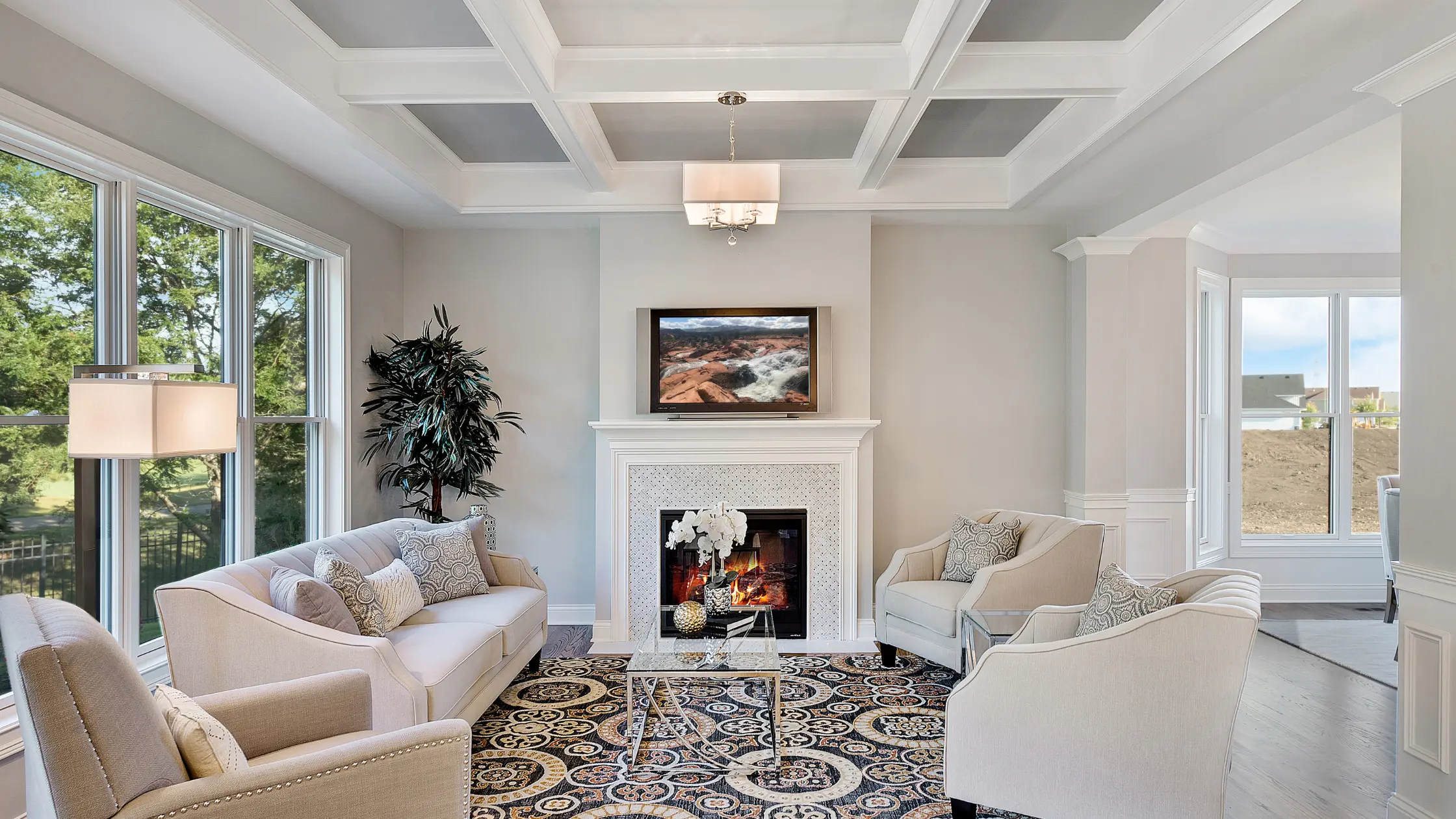
The transformative power of light colors in making a small home feel both luxuriously big and inviting is often underestimated. Light hues work wonders by reflecting light, thus creating a sense of spaciousness that dark shades simply cannot match. When applied thoughtfully throughout your home, these paler tones can make cramped spaces appear more open and breathable.
Consider the serene elegance of soft whites, gentle beiges, or subtle pastels as the primary palette for your walls. These shades serve as an excellent backdrop, promoting a luminous and airy atmosphere. It’s like having a canvas that not only brightens but also enlarges your living area visually.
In addition to painting walls with light colors, think about extending this strategy to large pieces of furniture and floor coverings. A light-colored sofa or rug can blend seamlessly with the surroundings instead of drawing boundaries that chop up space. This holistic approach ensures continuity, further enhancing the expansive feel within your home.
Moreover, incorporating variations within the same color family adds depth and interest without sacrificing cohesiveness or visual space expansion goals. Textures play a crucial role here—consider adding elements like plush throw pillows or soft draperies in slightly varied hues to introduce contrast softly.
11. Hang Your Television
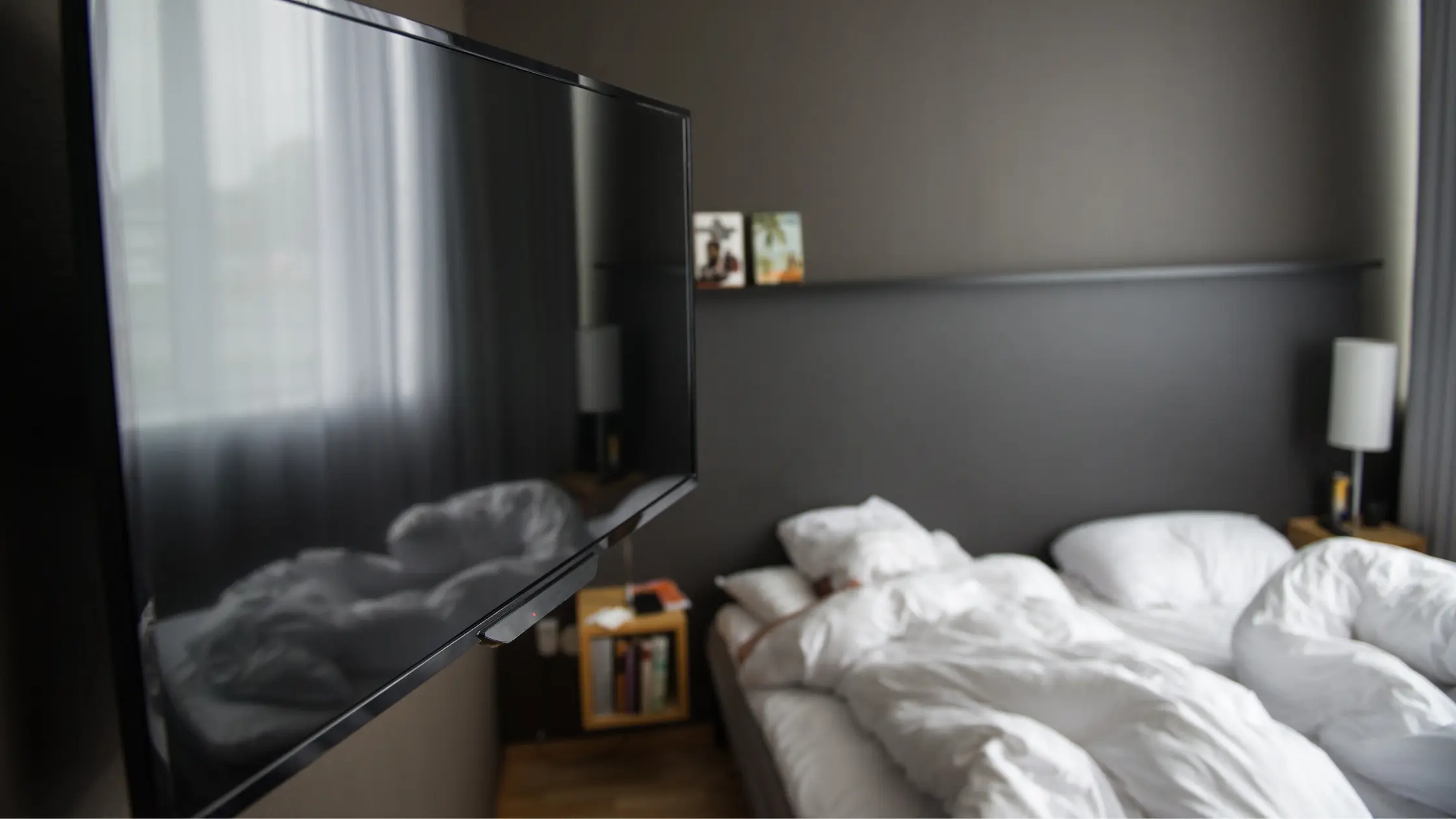
Hanging your television on the wall is a sleek and modern approach to optimizing space in small homes, contributing significantly to an atmosphere of luxury and openness. This method not only frees up valuable floor area but also elevates the device to become part of your home’s design aesthetic rather than just a bulky piece of technology.
The strategic placement of a wall-mounted TV can create a focal point in living spaces, around which furniture can be thoughtfully arranged for optimal viewing and conversation flow. This setup enhances the room’s functionality while maintaining a minimalist vibe—essential elements for luxurious living environments.
To further integrate the television into your decor seamlessly, consider installing it within built-in cabinetry or surrounded by art pieces that complement its presence. Such arrangements transform the screen into an element of visual interest even when turned off, ensuring it adds value to the room’s overall ambiance.
Moreover, cable management systems play a crucial role in maintaining sleek aesthetics; concealing wires behind walls or within discreet conduits keeps surfaces clean and uncluttered—a hallmark of sophisticated interior design.
12. Use Glass Doors
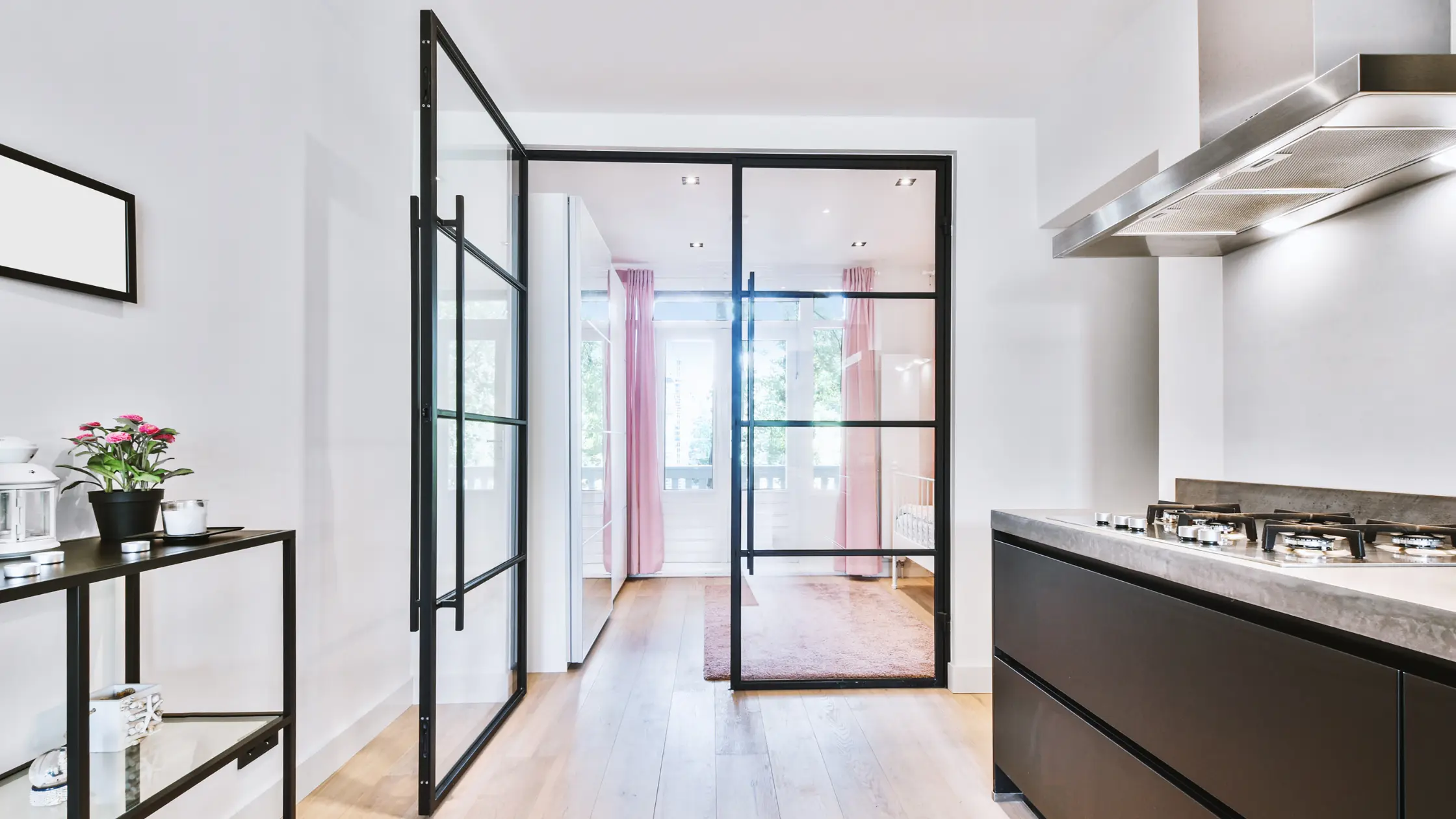
Using glass doors within small home designs is a transformative approach that marries functionality with the airy openness of modern luxury. This architectural choice leverages transparency to foster a sense of continuity between different areas, making spaces appear larger and more connected.
Glass doors allow natural light to permeate through multiple rooms, brightening interiors and creating an inviting warmth that enhances the perception of depth. Whether leading to outdoor areas or separating indoor spaces, their see-through nature extends sight lines far beyond physical walls, contributing significantly to the illusion of spaciousness.
To maintain privacy without sacrificing light flow, options such as frosted or tinted glass offer an elegant solution. These materials obscure direct views while still welcoming in daylight—a perfect balance for personal spaces like bedrooms or bathrooms.
Incorporating sliding glass doors can further optimize space usage; their sleek operation eliminates the need for clearance required by traditional swinging doors, freeing up valuable square footage for other uses.
Accentuating these installations with minimalistic frames—or even frameless designs—emphasizes a seamless blend between environments, encouraging a fluid transition that elevates the home’s overall ambiance.
13. Multipurpose Furniture
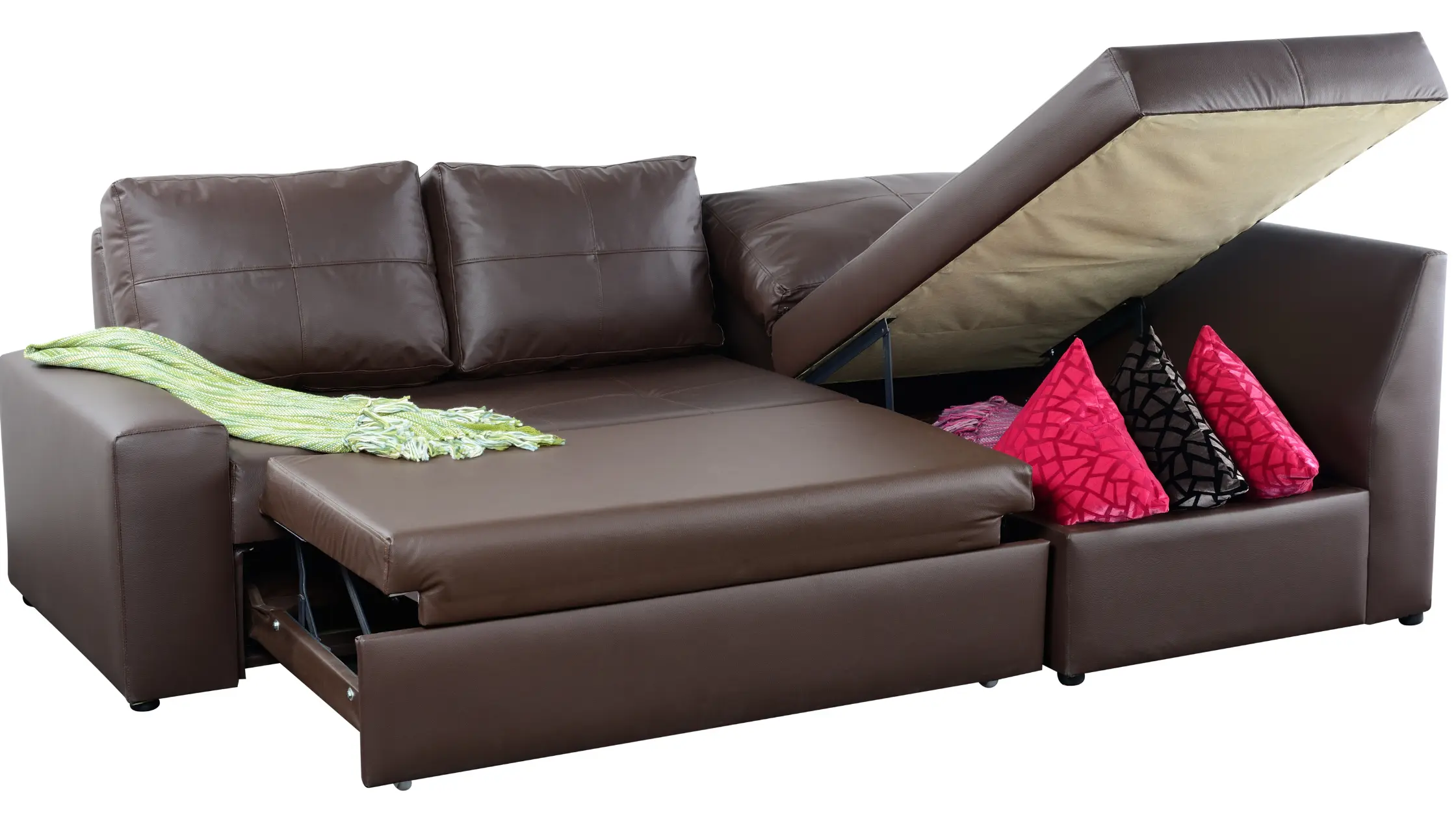
Adopting multipurpose furniture is akin to unlocking a secret passage to maximizing space within a small home, transforming it into an abode that feels both luxuriously expansive and functionally supreme. This innovative approach to furnishing not only conserves precious square footage but also infuses your living environment with an air of sophistication and clever design.
Imagine a sleek sofa that effortlessly converts into a comfortable bed at night or ottomans that serve double duty as hidden storage units. These pieces are not just furniture; they’re magic wands that wave away the constraints of limited space, allowing you to create an organized and spacious home without sacrificing style or comfort.
Dining tables with extendable features offer another brilliant example. Perfect for intimate dinners yet expandable for larger gatherings, they embody the essence of versatility. Similarly, wall-mounted desks can fold away when not in use, ensuring that every inch of your home serves multiple purposes while maintaining a clutter-free look.
Incorporating smart storage solutions integrated within these multipurpose items further elevates their utility—think beds with built-in drawers beneath or coffee tables featuring compartments for books and remote controls. Each piece becomes part of a greater strategy aimed at enhancing livability and luxury in compact quarters.
14. Raise Your Curtains
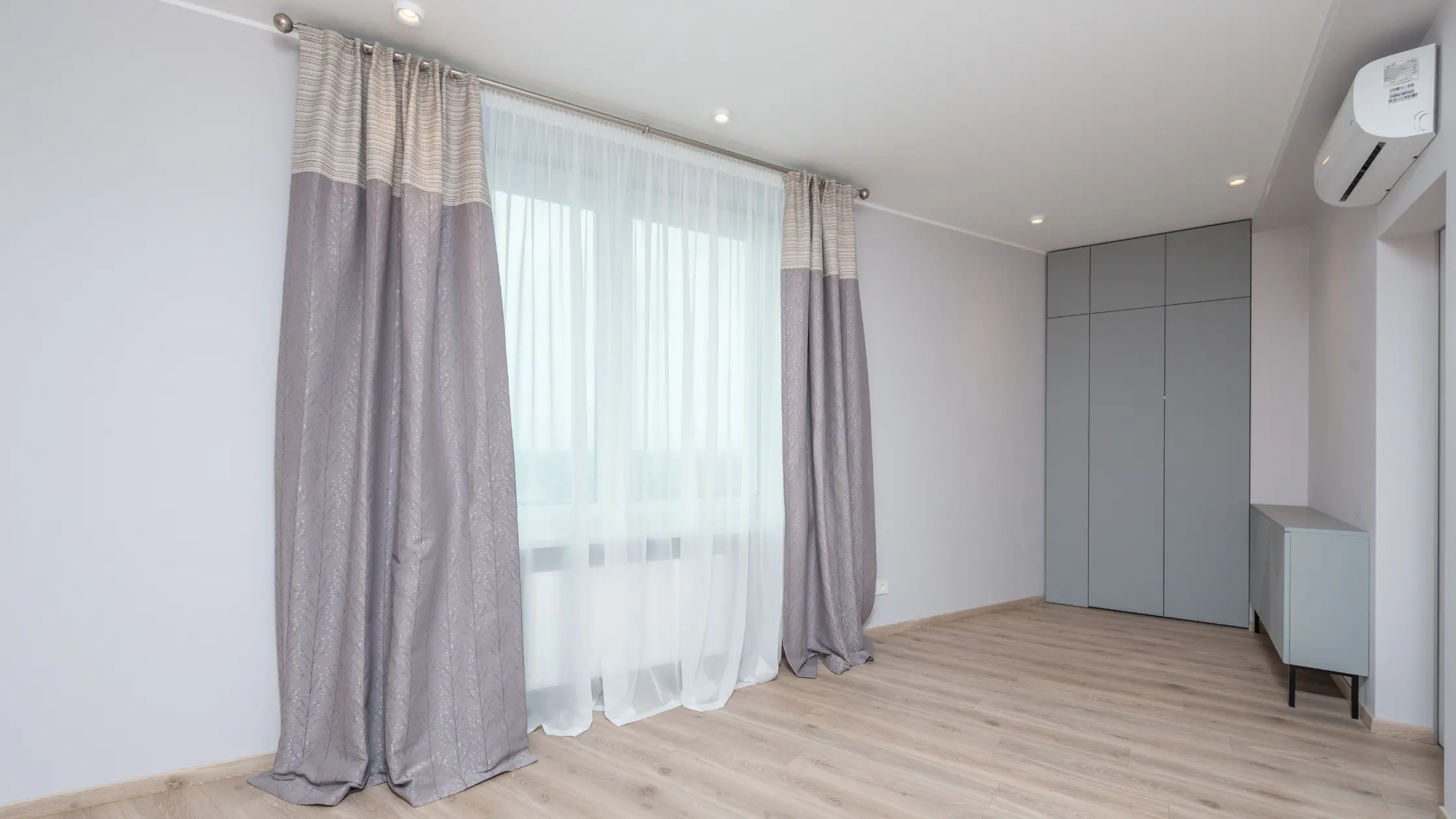
Elevating your curtains is a simple yet profoundly effective technique to create the illusion of height and spaciousness in any small home, imbuing it with an air of luxury that belies its actual dimensions. This strategy revolves around installing curtain rods closer to the ceiling rather than directly above windows. Such placement draws the eye upward, fostering a sense of vertical expansiveness that can make rooms feel significantly larger.
Opt for long, flowing drapes that reach all the way down to the floor. The uninterrupted line from ceiling to floor not only elongates your walls visually but also adds a touch of elegance and grandeur reminiscent of high-end residences. It’s an optical illusion; by extending fabrics vertically, you trick the mind into perceiving enhanced space beyond its physical confines.
Incorporating light and sheer materials for these elevated curtains further amplifies this effect by allowing natural light to filter through softly, brightening up your space without sacrificing privacy. The gentle diffusion creates an airy ambiance, reinforcing the feeling of openness within confined quarters.
Moreover, selecting shades or patterns that complement your overall interior design can seamlessly integrate this approach into your aesthetic goals. Whether aiming for minimalist chic or sophisticated opulence, raised curtains offer both functional benefits and decorative appeal—transforming ordinary spaces into extraordinary living environments.
15. Use Vertical Space
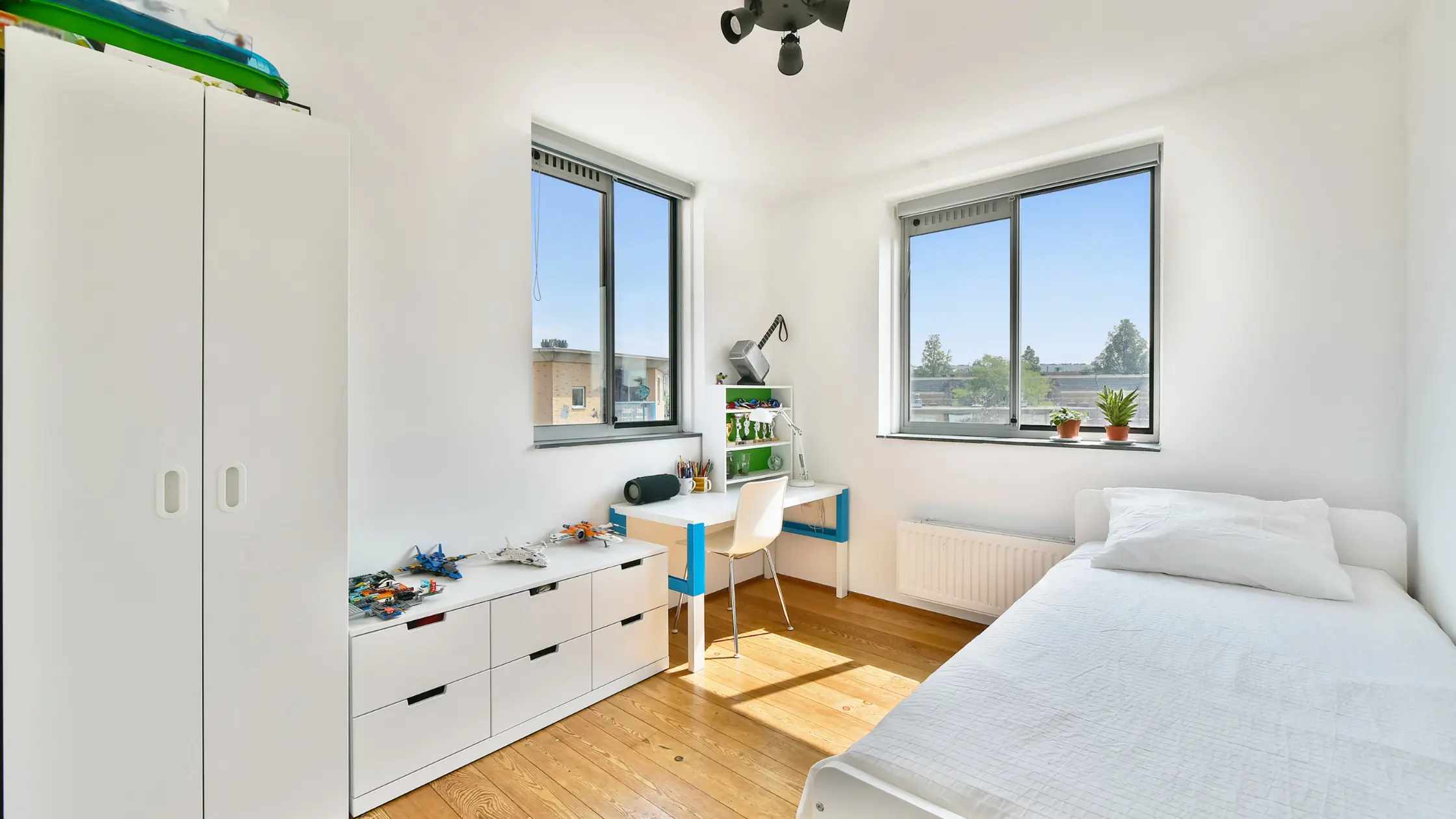
Harnessing the power of vertical space is akin to discovering a hidden dimension within your small home, allowing it to breathe and expand in ways you never thought possible. This strategy involves looking upwards and recognizing the untapped potential that lies above traditional eye level, transforming it into functional or decorative areas that contribute significantly to creating a sense of spaciousness.
Shelving units that stretch towards the ceiling not only draw the eye upward, thereby enhancing the feeling of height, but also provide invaluable storage solutions without encroaching on precious floor space. These towering structures can house everything from books to ornaments, turning clutter into an attractive display.
Similarly, installing wall-mounted cabinets or hooks can free up ground area while keeping essentials neatly organized. Consider placing these higher on walls than usual—this tactic encourages visual exploration of the entire room height and amplifies its perceived size.
For an artistic touch, try adorning your upper walls with vertically oriented artwork or mirrors. Such decor not only personalizes your space but also interrupts uniformity in wall heights—a clever trick for making ceilings appear loftier than they are.
Vertical gardening with hanging plants brings elements of nature indoors without sacrificing square footage. The cascading greenery adds depth and vibrancy while purifying air—blurring lines between indoor luxury and outdoor expansiveness.
16. Add Big Wall Art
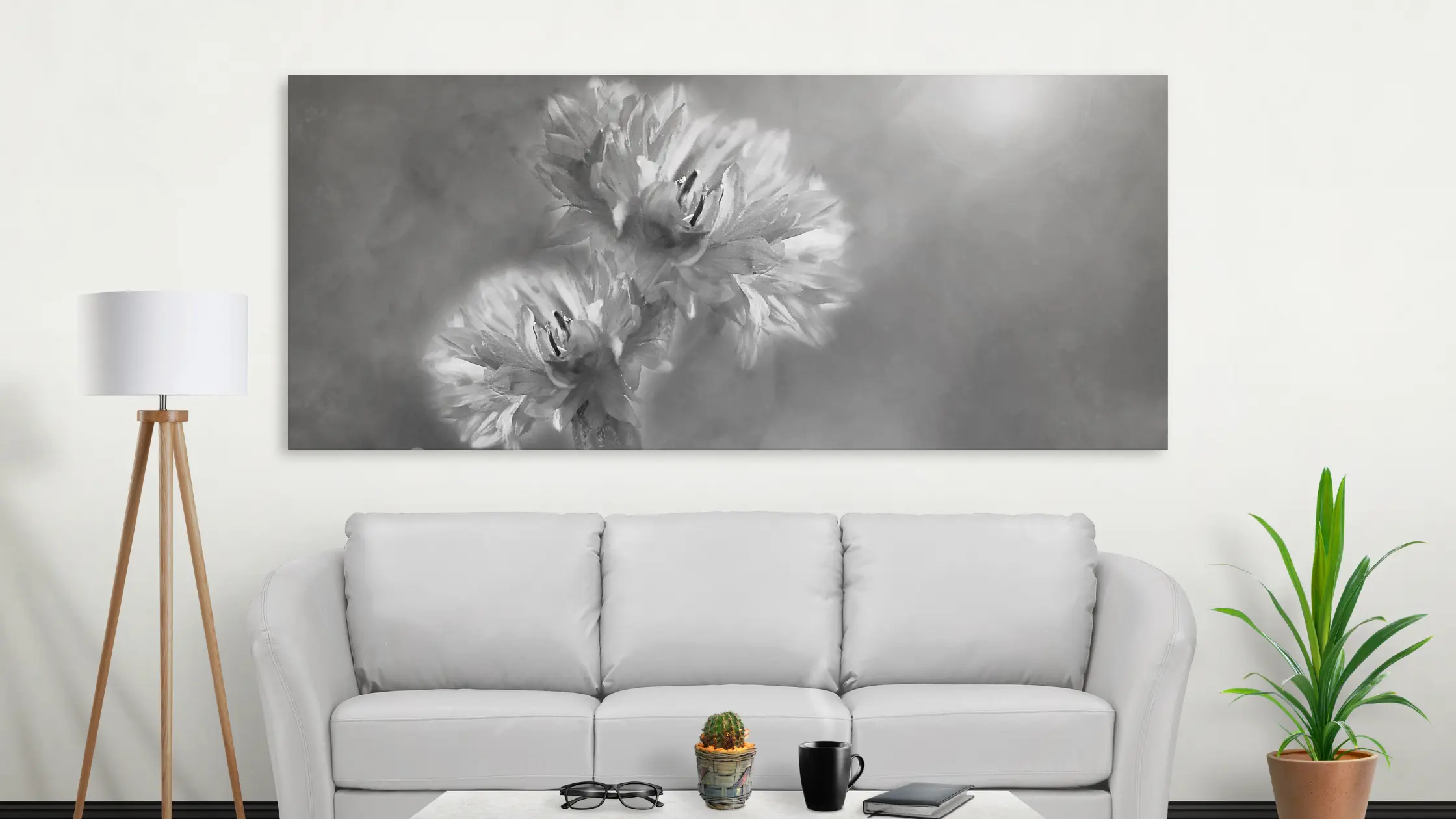
Adding big wall art is a bold move that can significantly elevate the perceived spaciousness and luxurious feel of small homes. This approach draws the eye, creating a focal point that dominates the room and shifts attention away from its size limitations. Large-scale artwork acts not just as decor but as a statement piece that injects personality and depth into your living space.
When selecting oversized pieces, consider artworks with expansive vistas or abstract compositions that invite contemplation. These visuals tend to open up the room, giving an illusion of extended space beyond the physical walls. The key lies in choosing art that harmonizes with your overall decor theme while standing out enough to capture interest and spark conversation.
To maximize impact, place large art strategically where it will be most visible—above the sofa in your living room or as a mesmerizing headboard alternative in your bedroom. Such placements ensure the artwork commands attention without overwhelming smaller elements in the room.
Incorporate lighting specifically designed to highlight your chosen piece; spotlighting or LED picture lights can enhance textures and colors, making the artwork pop even more against its surroundings.
17. Slim Furniture

Opting for slim furniture can dramatically alter the perception of space within a small home, transforming it into an environment that feels both more expansive and luxuriously appointed. This design strategy focuses on selecting pieces that boast lean profiles and sleek lines, thereby minimizing visual bulk and encouraging a sense of openness throughout your living space.
Choosing sofas, chairs, or tables with slender legs lifts them off the ground, creating an illusion of airiness and fluidity in rooms where every square inch counts. This elevation not only enhances floor visibility but also facilitates easier movement around the area—a key component in amplifying spatial generosity.
Moreover, slim furniture often features streamlined designs that prioritize functionality without sacrificing style. Such items can introduce modern elegance to any decor scheme while ensuring the room remains clutter-free and spacious. It’s about striking a balance between aesthetics and practicality; your furnishings should not overwhelm but rather complement the dimensions of your abode.
Incorporating pieces like floating shelves or wall-mounted consoles further embodies this philosophy by offering storage solutions sans the footprint of traditional bulky cabinets or shelving units. These alternatives maintain floor openness while still providing ample room to display decorative items or store essentials neatly out of sight.
18. Glass and Lucite
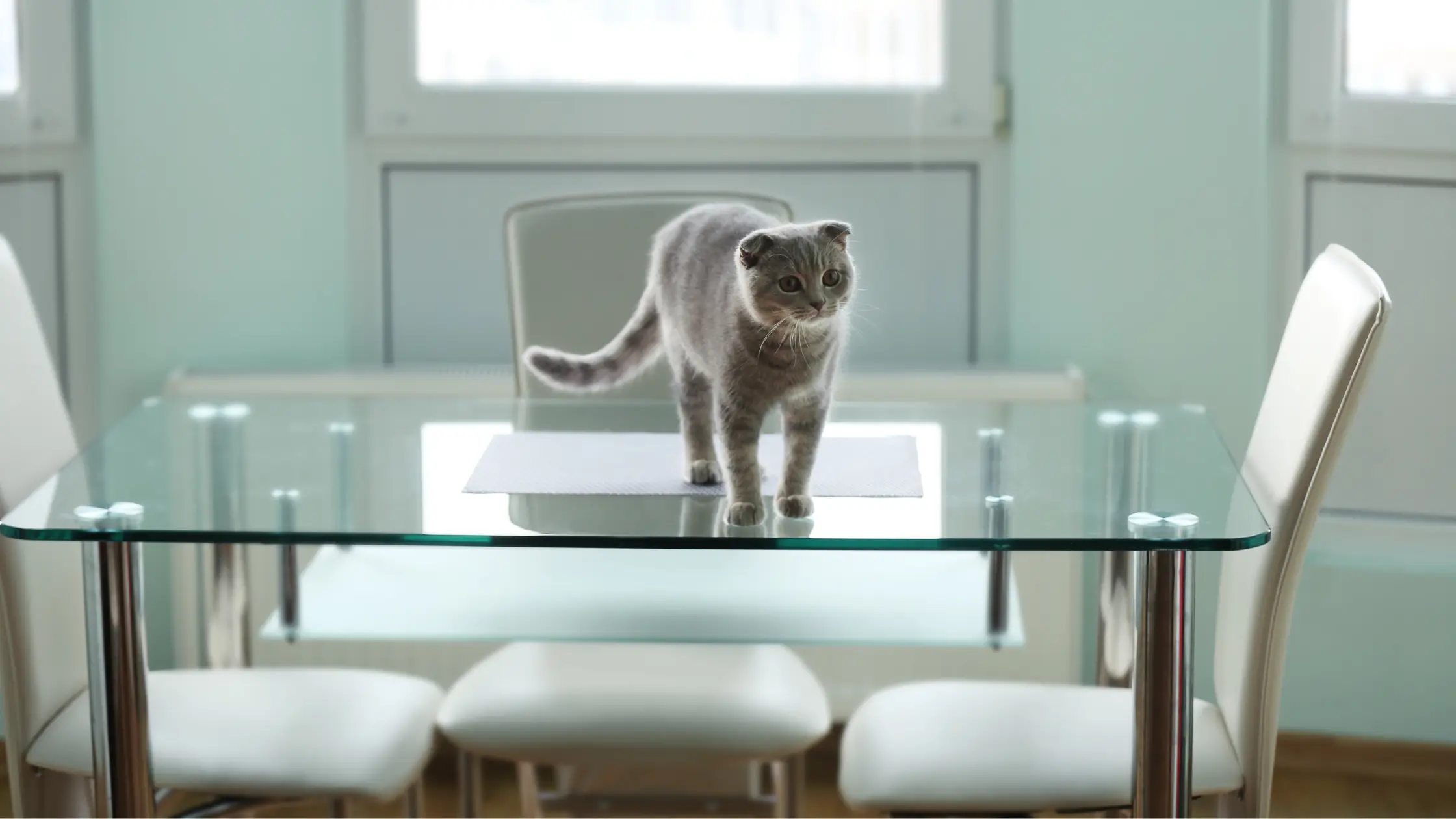
Incorporating elements of glass and Lucite into your small home’s decor is akin to performing a spell of spatial expansion, bringing an instant boost of openness and airiness that few materials can match. These transparent or translucent materials excel in blurring the boundaries within interiors, effectively making rooms appear more spacious than their actual square footage.
Furniture pieces like glass-top tables or Lucite chairs possess an almost ethereal quality, allowing light to pass through unimpeded. This characteristic ensures that they do not visually congest spaces but rather complement them by adding a touch of modernity and sophistication without overwhelming the eye. It’s as if these items occupy no space at all, yet they offer full functionality and style.
Moreover, utilizing glass shelves on walls serves a dual purpose: providing storage/display options while maintaining a sense of openness. These shelves seem to float against walls, minimizing visual clutter and promoting an environment where light flows freely—a crucial element in enhancing perceived room dimensions.
Integrating accent pieces made from these materials can also have a significant impact. For example, a Lucite console table placed in an entryway or behind a sofa adds utility without sacrificing precious visual real estate—the hallmark of thoughtful interior design tailored for limited spaces.
19. Lighting
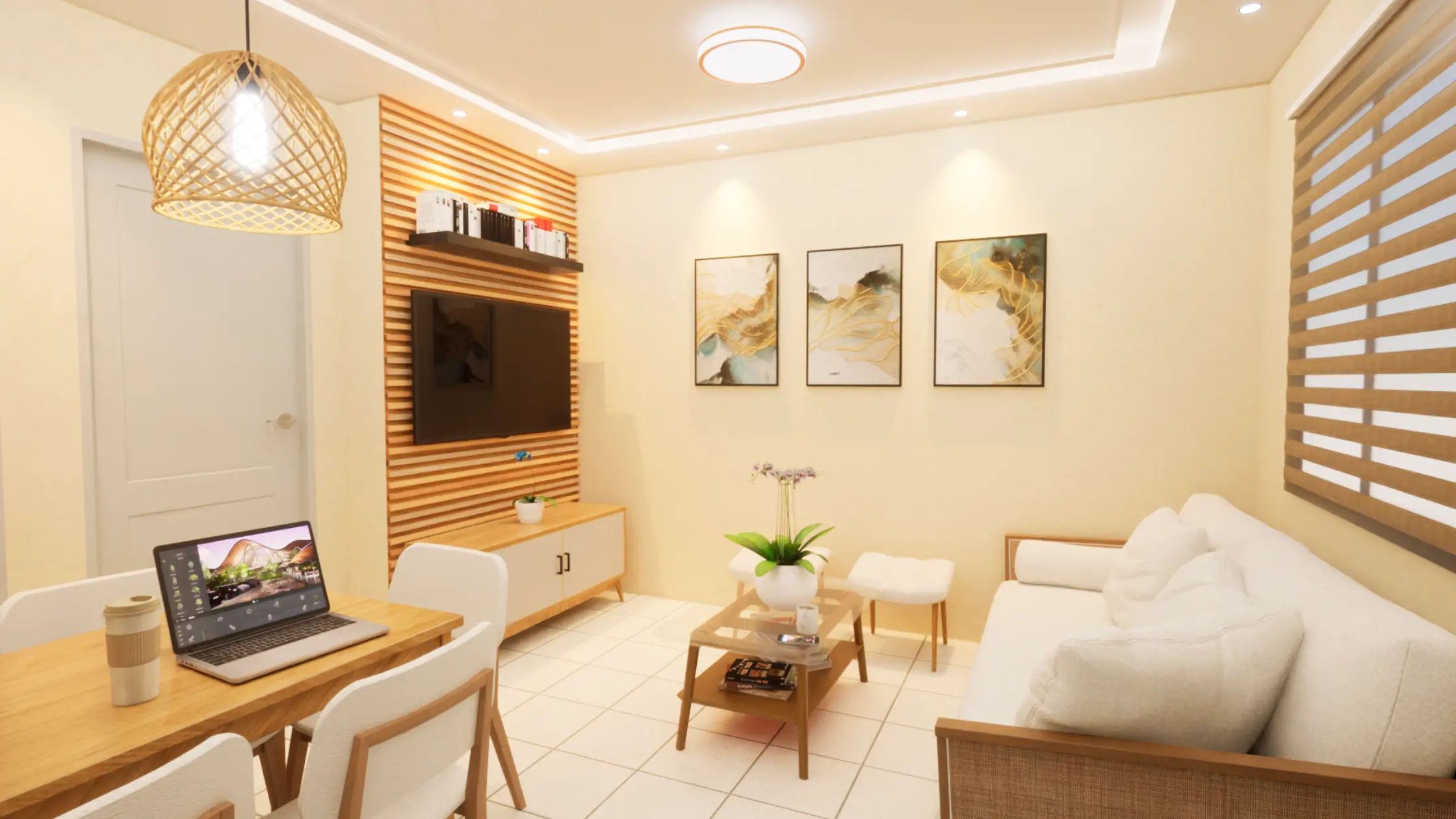
Mastering the art of lighting is essential when aiming to transform a small home into a space that feels both luxuriously big and welcoming. The strategic use of light can sculpt spaces, define areas within an open plan, and even influence perceived room dimensions. By layering different types of lighting, you create depth and highlight architectural features or key decor elements, adding to the overall luxurious feel.
Start with ambient lighting—the soft, general illumination that washes your living area in light. Think ceiling fixtures or recessed lights strategically placed to eliminate shadows in corners which can make rooms feel smaller.
Next, introduce task lighting for specific activities: under-cabinet lights in the kitchen for food preparation or table lamps beside seating areas for reading. These focused beams not only serve practical purposes but also add warmth to spaces.
Accent lighting plays a crucial role too; it’s all about creating visual interest and drawing attention to artworks, houseplants, or statement pieces. Track lights or spotlights can achieve this effect subtlety by casting purposeful shadows and textures across surfaces.
Consider also the magic of dimmer switches—they allow you to control intensity based on time of day or mood desired, instantly transforming atmospheres from bustling breakfasts to intimate dinners.
20. Rug Placement
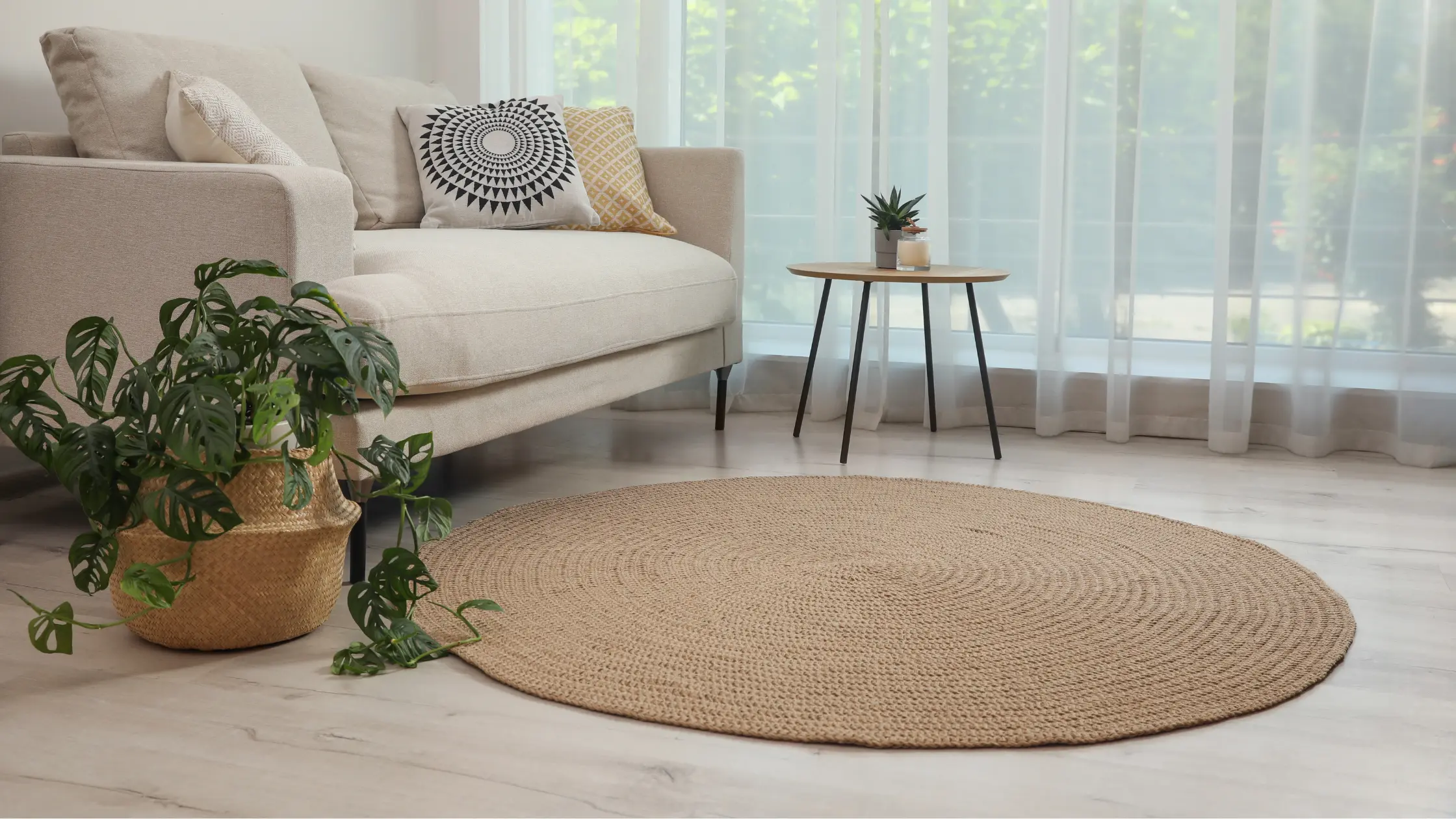
Strategic rug placement is a game-changer in visually expanding the confines of a small home, adding both comfort and luxurious aesthetics to your living space. It’s not just about selecting a beautiful rug but also understanding how its position can influence perception, making rooms appear larger and more cohesive.
Choosing the right size is crucial—a common mistake is opting for a rug that’s too small, which can fragment the room and make it feel cramped. Instead, aim for larger rugs that extend under furniture pieces; this creates an illusion of continuity and fluidity across the floor. By having sofas or chairs partially on top of the rug, you anchor your furnishings together, generating an intimate grouping that feels expansive rather than confined.
Another clever tactic involves aligning rugs with architectural cues—placing them parallel to walls or key features like fireplaces enhances visual symmetry and draws attention to room dimensions subtly.
For open-plan homes, utilizing multiple area rugs can demarcate different zones (living area from dining space) without physical barriers. This segmentation through soft textiles enriches spatial dynamics while maintaining an airiness around each defined area.
Consider also the visual impact of patterns; subtle stripes or linear designs can elongate spaces further when oriented lengthwise down a room.
21. Strategic Color Pops
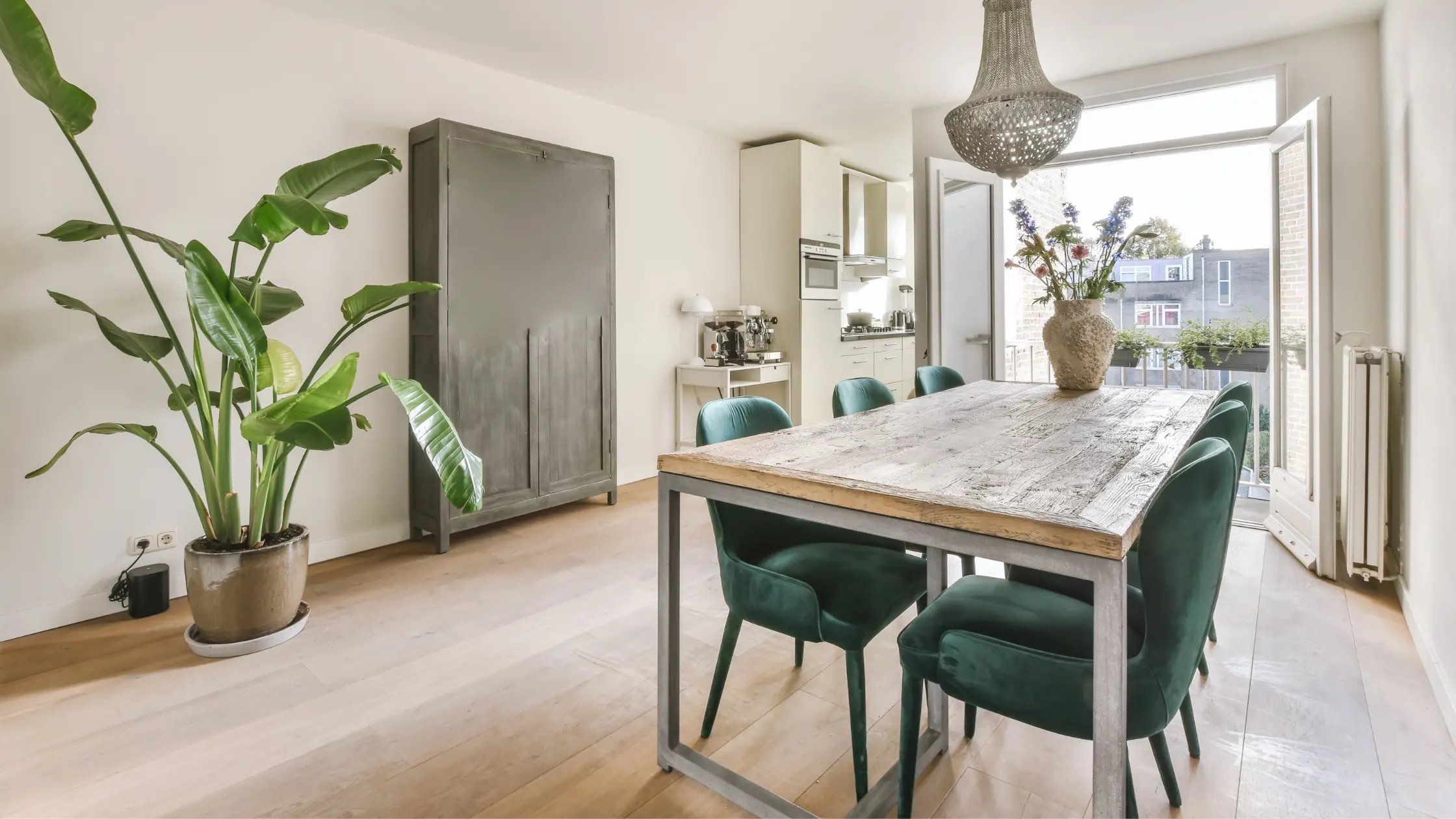
Introducing strategic color pops into your small home can dramatically shift its atmosphere from mundane to magnificently spacious and vibrant. This savvy approach hinges on the principle of balance—using bold, vivid hues judiciously to accent neutral backgrounds without overwhelming the senses. It’s an art form that combines subtlety with impact, drawing eyes towards focal points and creating depth that makes spaces feel more expansive.
Consider choosing a signature shade or two that reflects your personal style or evokes a desired mood. These colors can then be sprinkled throughout the space in various forms: plush throw pillows on a sleek sofa, vibrant artwork adorning white walls, or colorful vases perched on open shelving. Each element acts like a visual spice, adding layers of interest and energy to rooms.
The magic lies not just in the choice of colors but also in their placement. Accent pieces strategically positioned at different heights and locations around a room lead the eye on a journey through space, effectively stretching perceived boundaries beyond actual confines.
Moreover, integrating these pops of color within textiles (like rugs or curtains) introduces texture variance that enriches spatial perception further—softening hard lines and inviting touch.
22. Under-Bed Storage
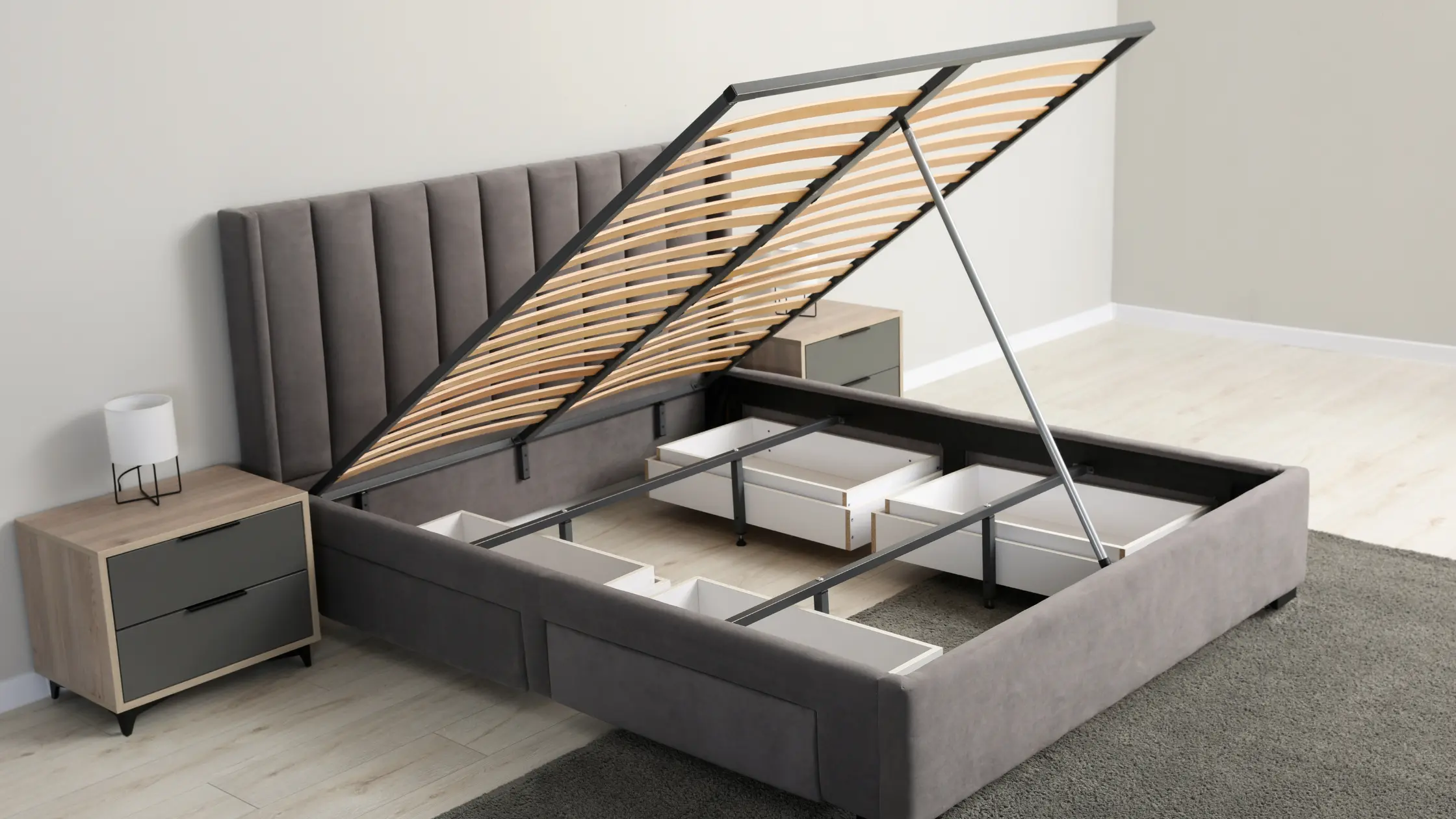
Leveraging under-bed storage effectively is akin to unlocking a secret chamber of space in your small home, offering an ingenious solution to declutter and organize while maintaining a luxurious, expansive feel. This often-overlooked area can transform into a treasure trove for items that aren’t needed daily, yet require accessible storage.
Opting for beds designed with built-in drawers offers a sleek and seamless way to incorporate additional storage without sacrificing aesthetics. These compartments are perfect for stowing away off-season clothing, extra bedding, or bulkier items that can consume valuable closet space.
Alternatively, stylish bins or baskets tailored to fit the dimensions beneath your bed can serve both functional and decorative purposes. Select materials and colors that complement your bedroom’s theme—enhancing the overall ambiance while keeping personal belongings neatly out of sight.
For those aiming to elevate this strategy further, consider utilizing vacuum-sealed bags within under-bed containers. This method not only maximizes available space but also protects stored items from dust and moisture—an essential consideration for preserving their condition over time.
Emphasizing organization in this concealed zone is crucial; categorize contents logically so retrieving them becomes hassle-free. Implementing dividers within drawers or labeling containers externally ensures quick access when specific articles are needed.
23. Floating Shelves
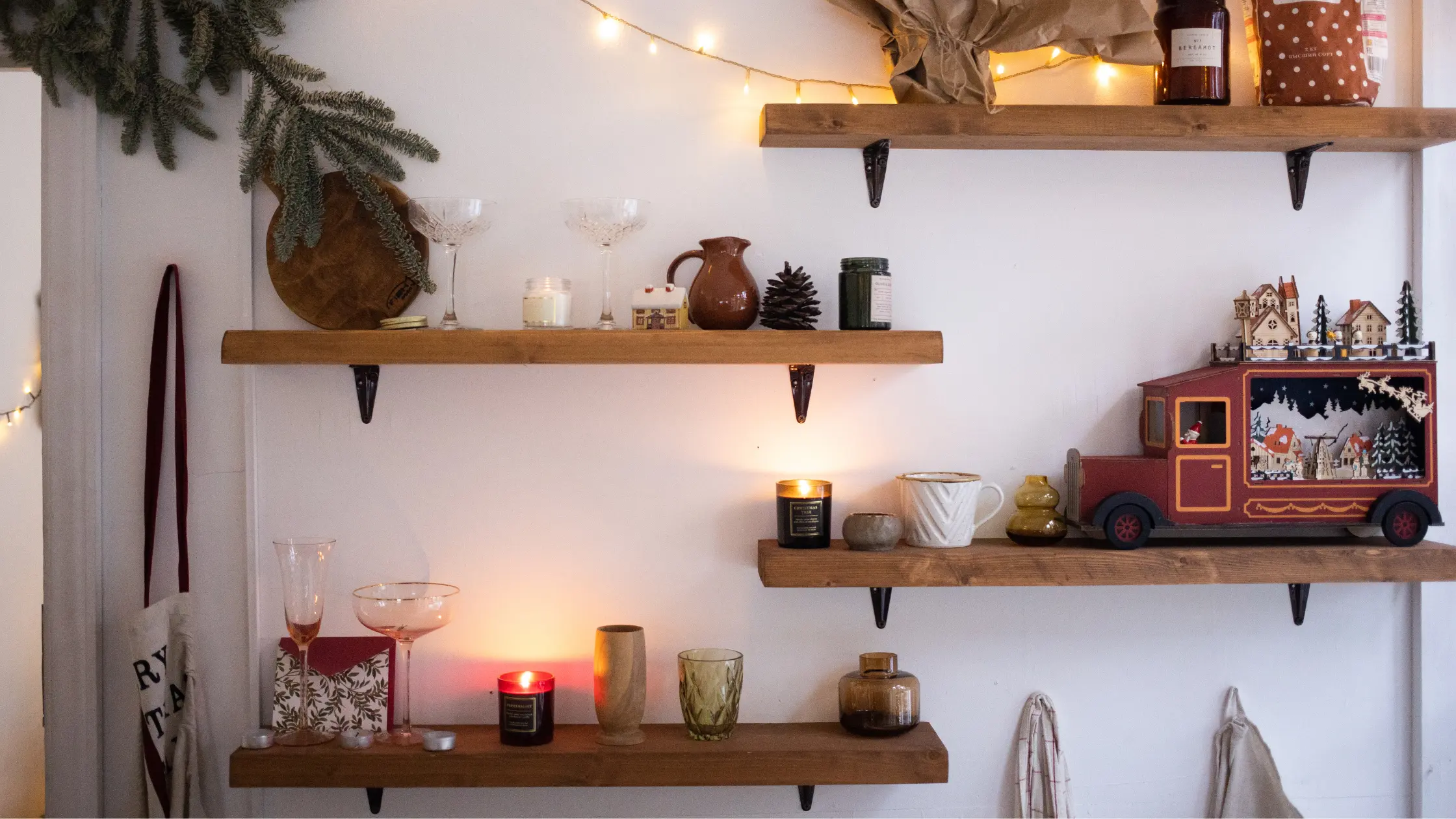
Integrating floating shelves into your small home’s decor is not merely about adding storage—it’s a strategic move to infuse luxury and an illusion of more space. This sleek, modern solution elevates items off the floor, freeing up precious square footage while providing a visually appealing display area that draws the eye upward, enhancing the perception of height in any room.
The beauty of floating shelves lies in their versatility. Positioned above workspaces or in kitchen areas, they can keep essentials within reach without cluttering countertops. In living spaces or bedrooms, they offer an ideal platform for showcasing books, art pieces, or personal treasures—all contributing to a personalized aesthetic that feels both spacious and sumptuously curated.
For added impact, consider arranging these shelves asymmetrically or at varying heights. Such configurations break up wall monotony and create dynamic visual interest that can make walls appear further back than they are—an effective trick for expanding perceived room dimensions.
Selecting materials and finishes that compliment your interior design scheme ensures these functional features blend seamlessly with the overall look and feel of your home. Whether opting for natural wood tones to warm up a space or glossy finishes for a contemporary vibe, floating shelves adapt effortlessly to amplify both style and spatial luxury.
Moreover, incorporating LED strip lighting beneath shelving units introduces ambient light—casting soft shadows and highlighting displayed items spectacularly while contributing to the layered lighting essential in luxurious interiors.
24. Foldable Furniture
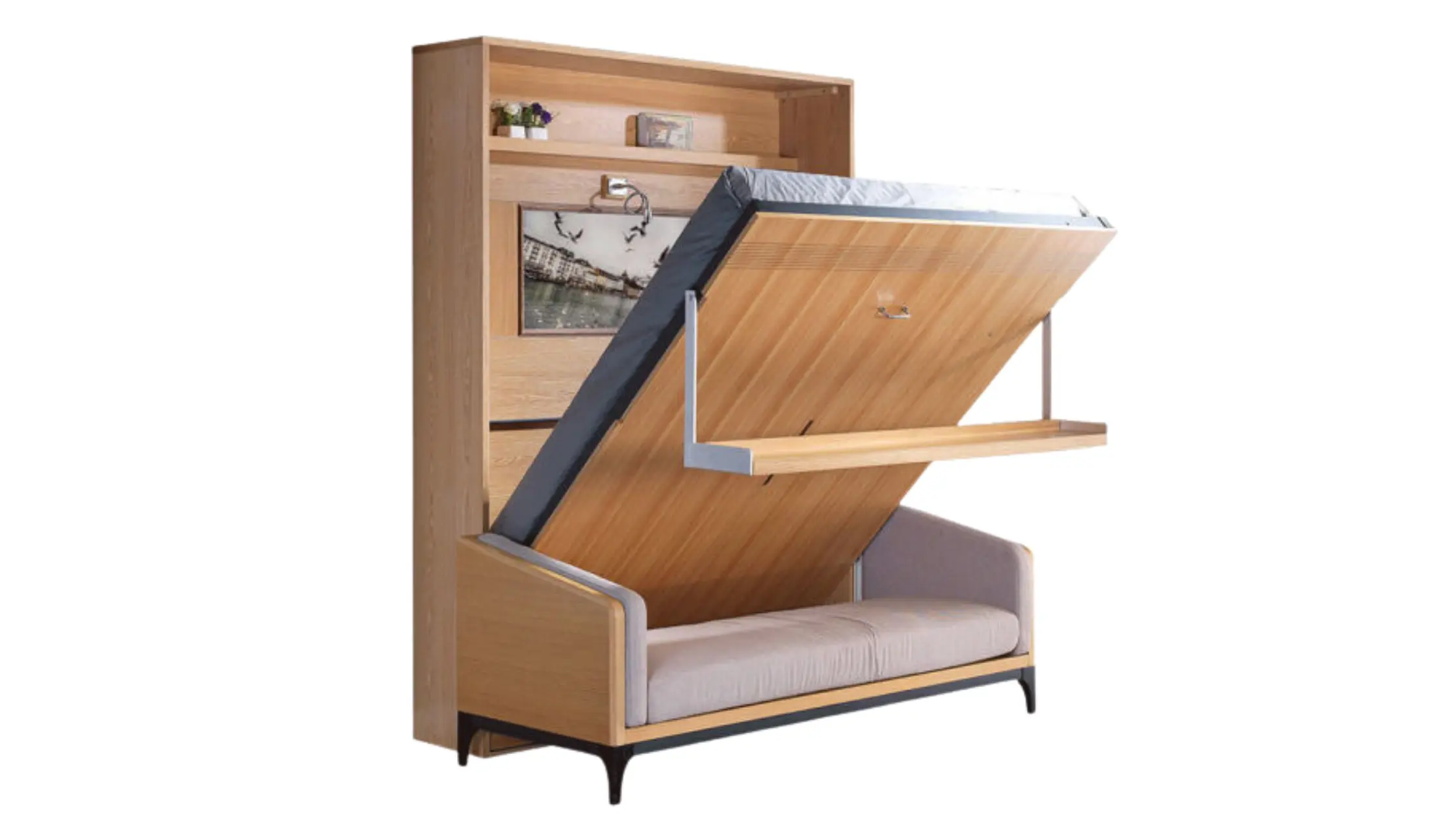
Foldable furniture stands out as a revolutionary ally in transforming compact living spaces into areas that feel both luxuriously spacious and dynamically versatile. This category of furnishings is designed to adapt seamlessly to your lifestyle needs, offering the freedom to reconfigure and reclaim your space at a moment’s notice.
Imagine the convenience of a dining table that expands to accommodate guests for dinner but folds away neatly when not in use, allowing extra room for daily activities. Similarly, wall-mounted desks can be folded down to create an instant home office and then tucked away effortlessly, ensuring your living area remains uncluttered and airy.
The true genius of foldable furniture lies in its ability to blend functionality with style. Modern designs have evolved far beyond purely utilitarian concepts; today’s pieces are chic and sophisticated, capable of enhancing any decor scheme while providing practical solutions to space limitations.
Strategically incorporating these transformative pieces into small homes not only maximizes available square footage but also introduces an element of luxury through smart design—where each item serves multiple purposes without compromising on aesthetics or comfort.
Moreover, selecting items with sleek lines and lightweight materials can further contribute to creating an open, expansive feel within confined quarters. The key is choosing wisely—opting for quality over quantity—to ensure every piece adds value both functionally and visually.
25. Uniformity In Decoration
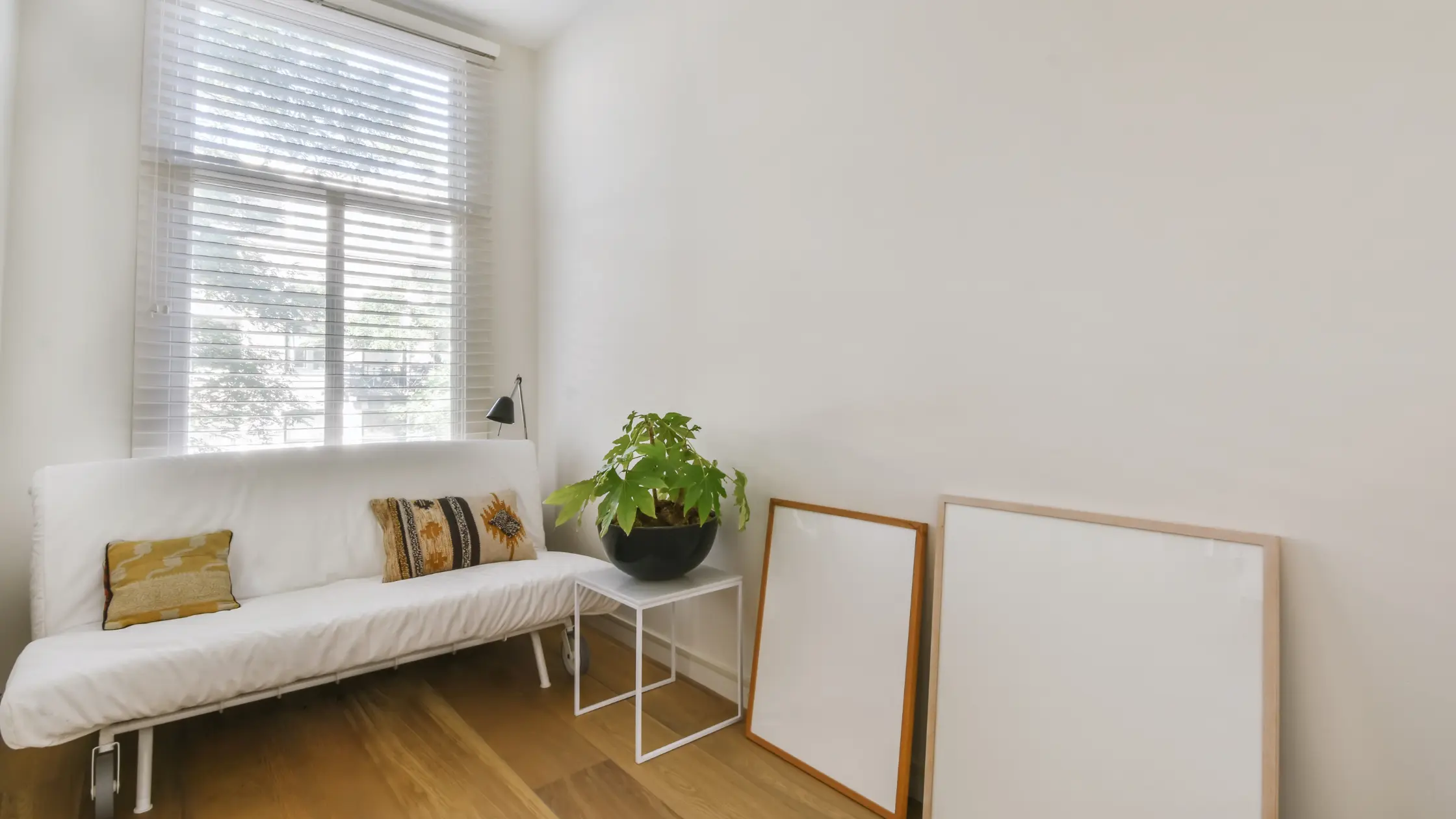
Achieving uniformity in decoration is a subtle yet powerful strategy for amplifying the sense of space within small homes, creating an environment that feels both cohesively luxurious and expansive. This approach relies on the careful selection of colors, textures, and patterns that harmonize across different areas of your home, fostering a seamless flow from room to room.
Opting for a consistent color palette is foundational to this method. Soft, neutral tones can serve as a base, making spaces appear larger by reflecting light while providing a serene backdrop for pops of color through accessories or artworks. The repetition of these hues throughout your living area enhances continuity, visually expanding confines by blurring boundaries between separate zones.
Similarly, maintaining uniformity with materials and finishes—be it in furniture upholstery, curtain fabrics or flooring—reinforces this effect. When each element resonates with others around it through texture or pattern alignment, rooms feel connected and therefore more spacious.
The strategic use of decorative accents plays into this theme as well; choosing items like cushions, vases or lamps in matching styles or complementary shades unites disparate sections of living spaces under a single design vision.
26. Minimalist Style

Adopting a minimalist style can significantly amplify the luxurious and spacious feel of small homes, making it a popular design choice for those seeking simplicity and elegance. This approach focuses on the philosophy of ‘less is more’, emphasizing clean lines, uncluttered spaces, and a monochromatic color palette that together create an atmosphere of tranquility and openness.
At its core, minimalism advocates for thoughtful reduction—each item within your space should serve a purpose or bring joy. By eliminating excess furnishings and decor, you allow the architecture of your home to shine while also facilitating easier movement and visual flow throughout different areas.
Furniture selection becomes paramount in minimalist interiors; opt for pieces with simple silhouettes that provide functionality without overwhelming the space. Quality over quantity reigns supreme here—investing in well-crafted items that withstand time not only ensures durability but also contributes to the overall aesthetic appeal.
Color plays a crucial role as well; sticking to neutral tones helps in creating a cohesive look that visually expands small spaces. Accents can be introduced through textures or natural elements like wood or stone, adding depth without disrupting the serene vibe.
Lighting too must be considered carefully—the right fixtures can highlight architectural features and open up rooms dramatically.
27. Use Reflective Surfaces
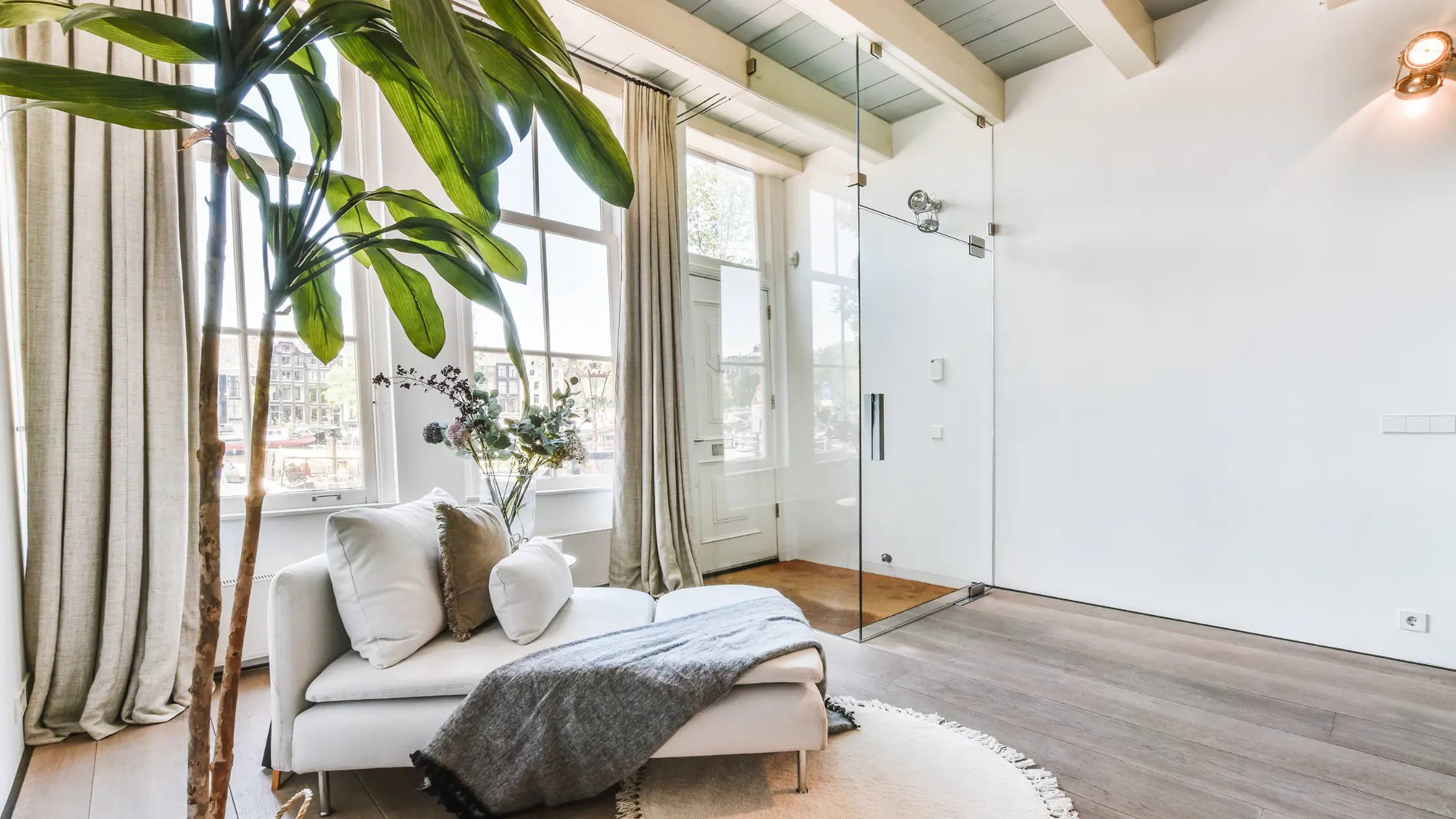
Integrating reflective surfaces into your home decor strategy is a brilliant move to visually expand small spaces, infusing them with an air of luxury and depth that goes beyond their physical boundaries. This technique manipulates light and perspective, creating illusions of expansiveness by bouncing natural and artificial light throughout the room.
Mirrored walls or decorative panels can instantly double the visual space in a room, making it appear as if it extends far beyond its actual confines. Similarly, furniture pieces with glossy finishes or glass tops add subtle reflections that contribute to this effect without overwhelming the space.
Metallic accents in silver, gold, or brass on hardware fixtures like knobs, handles, or lighting also play into this theme beautifully. They not only introduce an element of sophistication but also catch and scatter light across their surroundings—brightening dark corners and making rooms feel more open.
Flooring choices matter too; polished stone tiles or lacquered wood floors offer sheen underfoot that enhances spatial perception when hit by light.
Thoughtful placement is key—position reflective items where they can maximally harness daylight during different times of the day for an ever-evolving dynamism within your living environment.
28. Statement Lighting
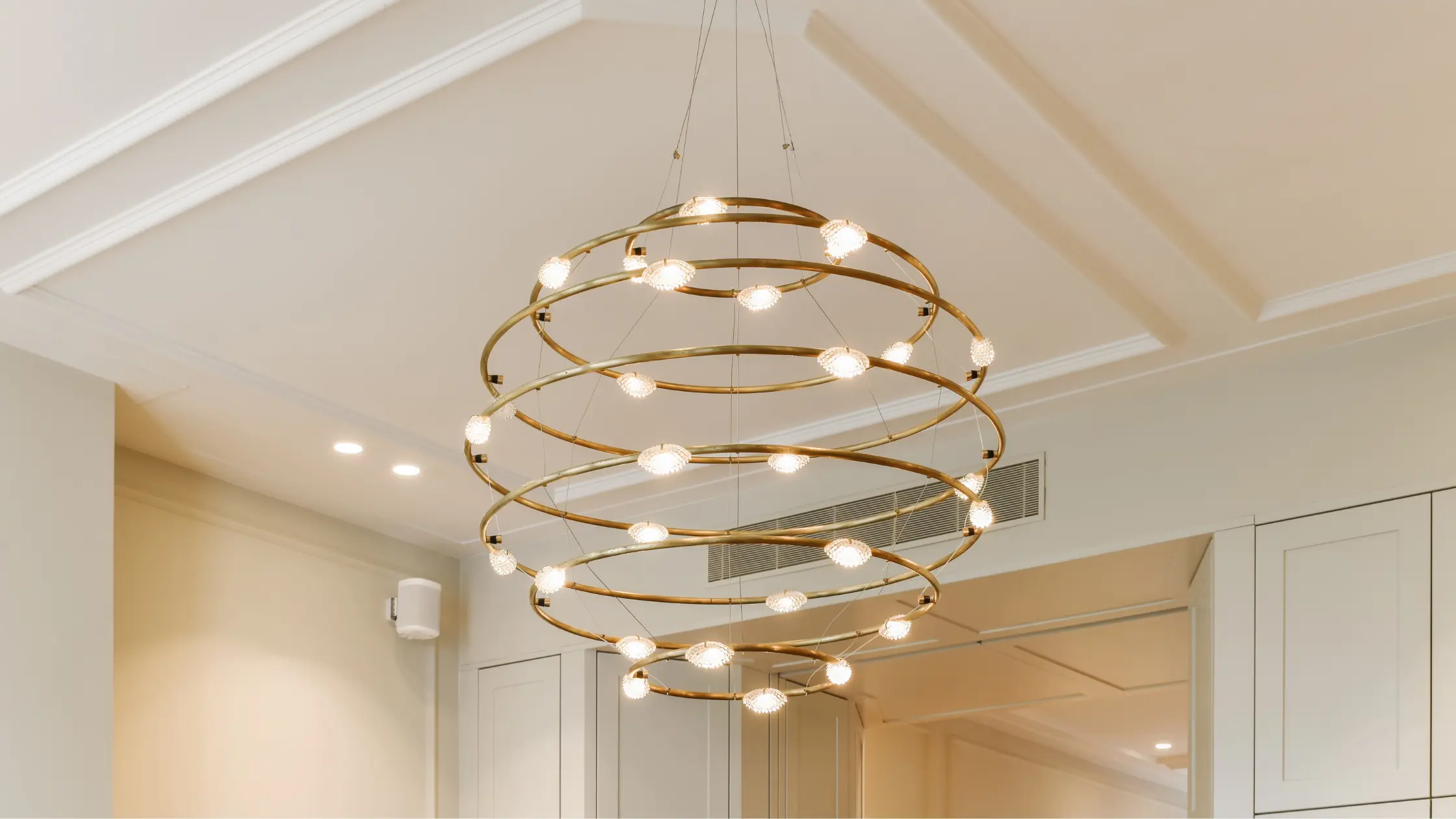
Choosing statement lighting can dramatically transform small spaces, elevating them from merely functional to magnificently luxurious. This strategy revolves around selecting bold, eye-catching fixtures that not only illuminate but also serve as artful centerpieces, drawing attention and creating focal points within the room.
The beauty of statement lighting lies in its ability to inject personality into a space without occupying valuable square footage. A dramatic chandelier hanging over a dining area or an oversized pendant light in the living room can set the tone for the entire home—a blend of sophistication and modern flair.
When incorporating such striking pieces, consider scale carefully; while you want the fixture to stand out, it should not overwhelm the space. The key is finding balance—opting for lights that complement rather than dominate your decor scheme.
Layering plays a significant role here as well. Pair your statement piece with subtler accent lights to achieve depth in lighting design. This technique allows for flexibility—brightening up areas for specific tasks or dimming down for ambient evenings—all while maintaining that luxurious feel.
Moreover, think beyond traditional placements; unique floor lamps beside a reading nook or artistic sconces flanking a gallery wall can amplify visual interest throughout your home.
29. Invisible Storage
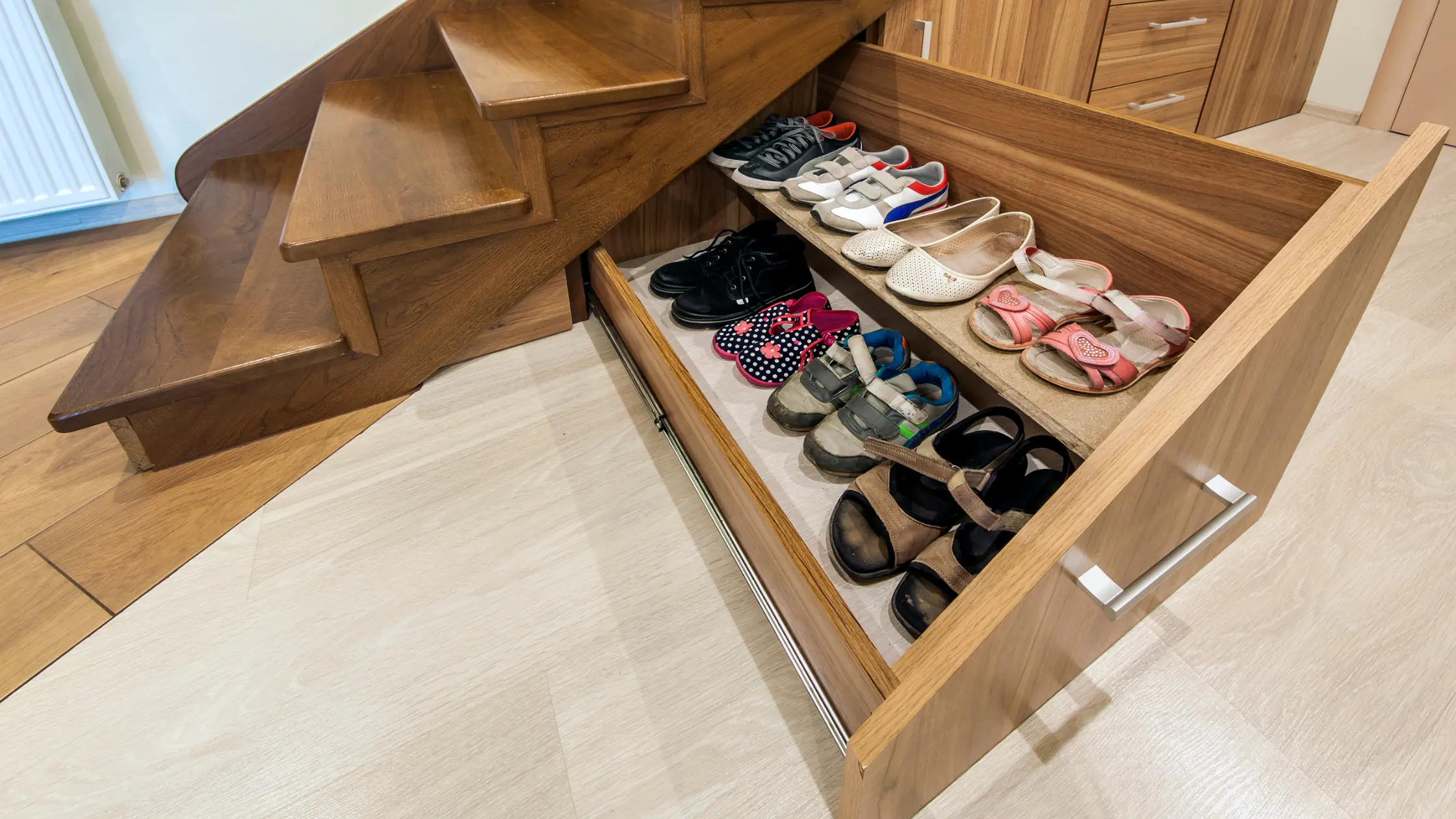
Leveraging invisible storage solutions is a smart and stylish way to declutter your small home, making it feel both luxuriously big and impeccably organized. This innovative approach focuses on integrating storage into the home’s design in such a seamless manner that it virtually disappears from view, thereby maintaining clean lines and an uncluttered aesthetic.
Think built-in cabinets that blend with wall colors or under-stair drawers that tuck away seamlessly—these options minimize visual disruption while maximizing available space. Even multi-functional furniture, like beds with hidden compartments or ottomans doubling as storage boxes, contribute to this invisible strategy by keeping items out of sight without sacrificing style.
For those areas where open shelving is necessary, consider using transparent containers or baskets matching the room’s color scheme. By doing so, these storage units subtly blend into their surroundings rather than standing out starkly against them.
Another clever tactic involves recessing shelving into walls; this can create niches for books or decorative items in living areas or additional pantry space in kitchens without protruding into valuable living space.
Utilizing hidden panels or doors that conceal laundry units, kitchen appliances, or entertainment systems when not in use also plays a significant role in achieving an uninterrupted flow throughout your home.
30. Vertical Gardening

Vertical gardening emerges as a creative and lush way to introduce the luxury of nature into small homes, enhancing their sense of space and vitality. This method capitalizes on upward growth, using walls or hanging systems to cultivate plants in a way that occupies minimal floor space. The result is a living tapestry that adds depth, color, and texture to interiors while purifying the air—a true fusion of aesthetics and functionality.
Selecting the right plants is crucial for success; opt for varieties that thrive indoors and require similar light and water conditions. Succulents, ferns, and trailing vines are excellent choices due to their low maintenance needs and visual appeal.
Incorporating vertical gardens can be as simple as installing shelving units dedicated to potted plants or employing more sophisticated hydroponic systems directly mounted onto walls. Both methods allow you to customize your green display according to available light sources and personal taste.
Beyond their decorative benefits, these vertical oases can also serve practical purposes—herb gardens in the kitchen provide fresh ingredients at arm’s reach while flowering species add natural fragrance throughout your home.
Moreover, integrating mirrors near your garden setup can amplify light exposure for plants while visually expanding the green-covered area—an ingenious trick that further blurs indoor-outdoor boundaries.
31. Texture Over Patterns

Favoring texture over patterns emerges as a sophisticated strategy to craft spaces that feel luxuriously expansive within small homes. This design principle leans on the subtle complexity of materials to add depth and interest, without overwhelming tight quarters with busy visuals often associated with bold patterns.
Introducing a variety of textures can profoundly influence the perception of space; for instance, a plush velvet sofa against a smooth leather ottoman creates an interplay of tactile experiences that draw attention and make the room feel dynamic. Similarly, incorporating soft throw blankets or fluffy area rugs introduces elements of comfort and warmth, inviting one to enter and relax.
The key to effectively employing this approach lies in layering different textures while maintaining a harmonious color palette. Light neutrals serve as an ideal backdrop—they amplify natural light while providing contrast against which various materials can stand out.
Moreover, considering architectural elements such as exposed brick walls or wooden beams adds another layer of texture inherently tied to the structure’s character—further enhancing spatial richness.
Accent pieces like metallic vases or ceramic lamps contribute reflective surfaces that catch light differently throughout the day, subtly altering the room’s ambiance without resorting to patterned decoration.
32. Wall Niches
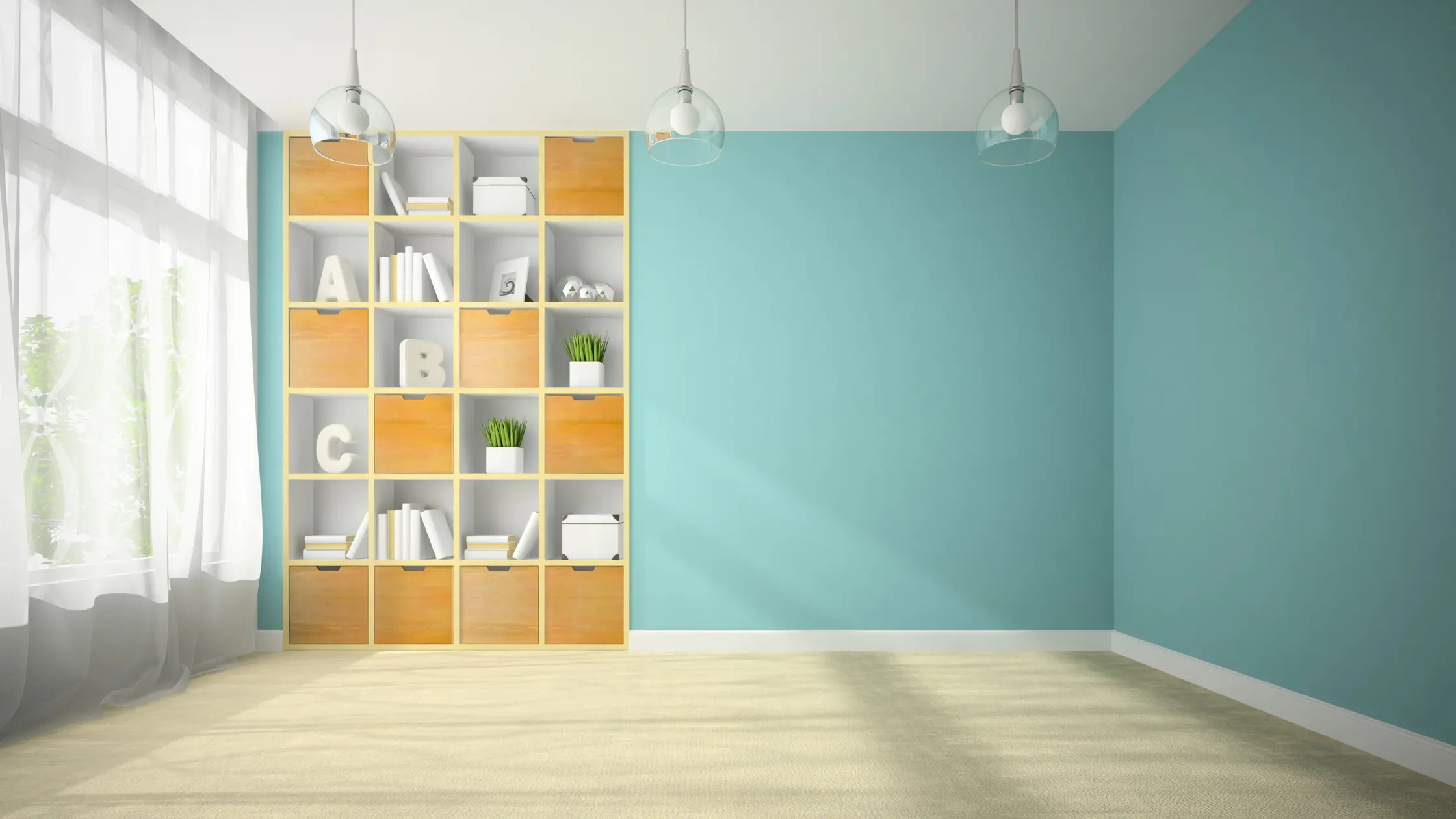
Utilizing wall niches is a clever and elegant way to enhance the spaciousness of small homes, marrying functionality with an air of bespoke luxury. These recessed areas offer a unique solution for storage and display without encroaching on valuable floor space, seamlessly blending into walls while providing visual interest and depth.
Incorporating wall niches into your design scheme allows you to showcase art pieces, sculptures, or cherished mementos in a manner that elevates them to focal points within the room. This not only personalizes the space but also draws eyes upward or across the wall, effectively making rooms appear larger by distracting from their actual dimensions.
Beyond aesthetics, niches can be pragmatically used in various parts of the home; in bathrooms for toiletries, in kitchens for spices or cookbooks, or near entryways as a convenient nook for keys and mail. The versatility of these architectural elements makes them invaluable in maximizing efficiency while maintaining sleek lines.
To further amplify their impact, consider adding accent lighting within each niche. This subtle touch can create ambiance during evenings while highlighting displayed items—transforming mundane walls into dynamic surfaces teeming with personality.
Moreover, experimenting with textures inside these cutouts—such as contrasting paint colors or backdrops featuring tile or wood finishes—can introduce layers of richness without overwhelming sensory input.
33. Adjustable Lighting
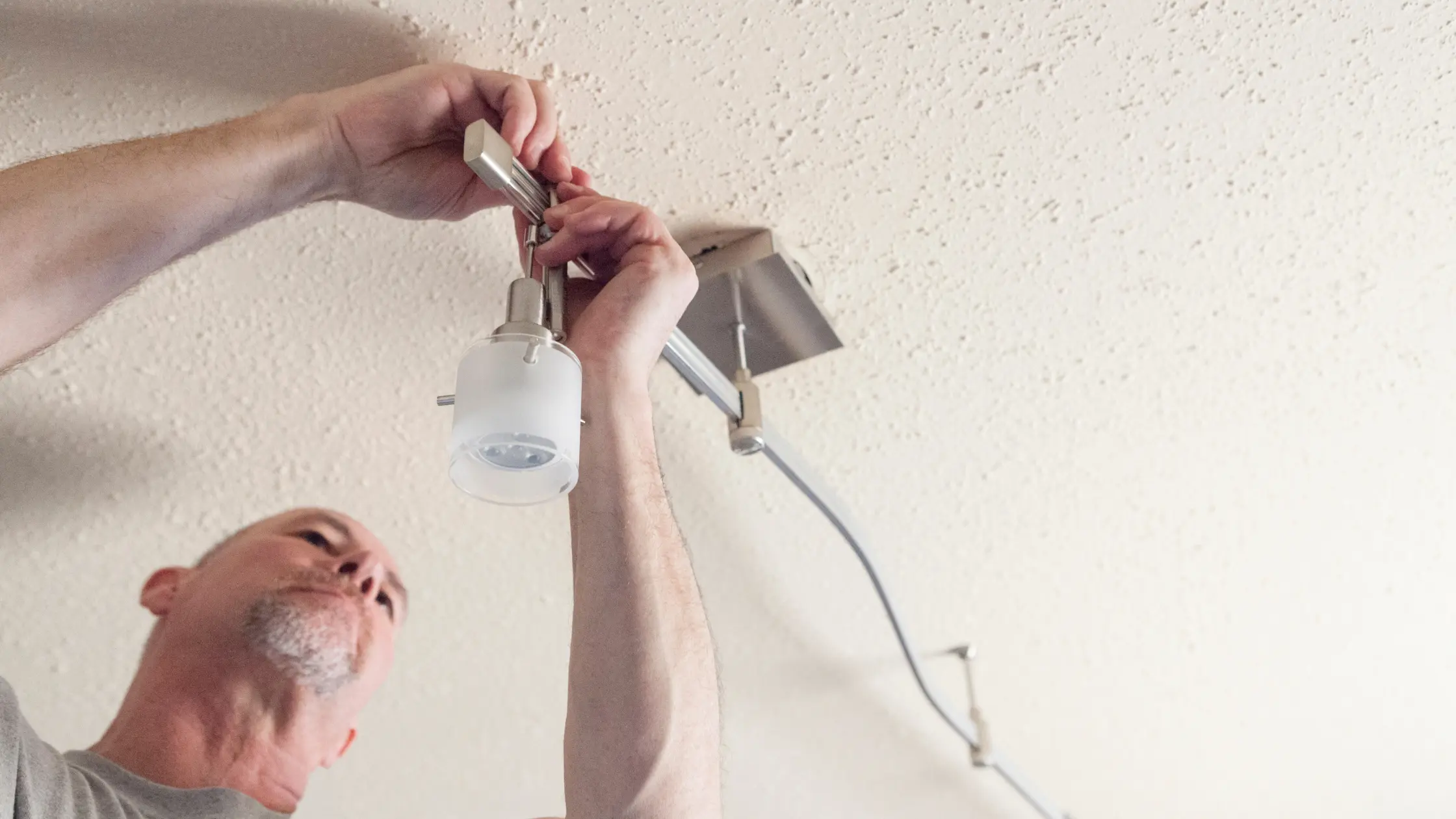
Adjustable lighting plays a crucial role in transforming small homes into spaces that feel both inviting and luxuriously expansive. This dynamic feature allows homeowners to tailor ambiance and functionality to suit different occasions, times of day, or specific tasks, thereby enhancing the versatility and perceived spaciousness of interiors.
Central to this approach is the strategic placement of dimmer switches on overhead fixtures, enabling a smooth transition from bright illumination for focus-oriented activities to softer glows conducive to relaxation. Such flexibility not only serves practical needs but also introduces an element of sophistication through customizable lightscapes.
Layering light sources further elevates this concept; combining ambient lighting with task and accent lights creates depth and dimension. For instance, under-cabinet LED strips can illuminate workspaces in kitchens without overpowering the room’s overall mood set by warmer pendant lights above.
Smart lighting systems represent another frontier in adjustable illumination. These technologies offer unprecedented control via smartphones or voice commands—allowing residents to adjust brightness levels, change colors, or even program automatic settings based on time or activity patterns seamlessly.
Moreover, attention to natural light enhances this strategy. Employing reflective surfaces or sheer window treatments maximizes daylight entry during daytime hours—reducing dependence on artificial sources while maintaining privacy.
34. Mirrored Furniture

Mirrored furniture reflects light, creating an illusion of a larger space. Incorporate pieces like mirrored dressers, coffee tables, or cabinets.
These reflective surfaces bounce light around the room, enhancing brightness and depth perception.
Strategically place mirrors opposite windows to maximize natural light and make your home feel airy and expansive.
Mirrored furniture also adds a touch of elegance and sophistication, blending seamlessly with various decor styles.
Opt for multifunctional pieces, such as mirrored storage units, to maintain a clutter-free environment while amplifying space perception.
With their sleek design and practical functionality, mirrored furniture transforms a small home into a luxurious, spacious retreat.
35. Hidden Storage Solutions
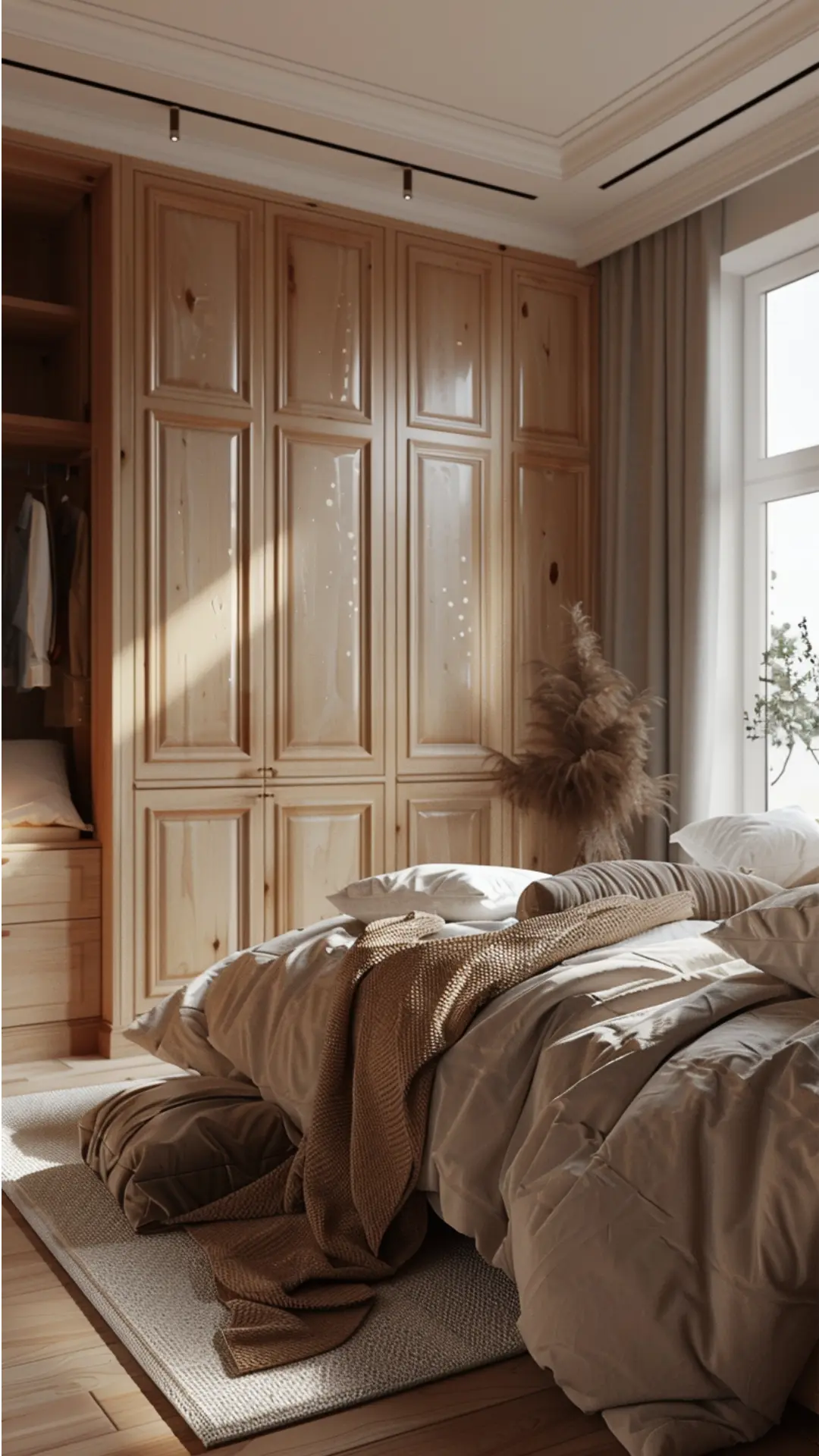
Maximizing space in a small home often involves clever hidden storage solutions. Utilize furniture with built-in storage, like ottomans or beds with drawers.
Consider installing shelves above doorways or within wall niches for additional space. Employ multi-functional items such as storage benches or coffee tables with hidden compartments.
Concealed cabinets and under-stair storage effectively utilize unused areas, reducing clutter. These smart storage options maintain a clean, open look while providing ample space for belongings.
By integrating hidden storage, your home will not only appear more spacious but also more organized and luxurious, enhancing both functionality and aesthetics.
